Netgear orporated 14300289 MoCA 2.0 N600 WiFi bridge / extender User Manual
Netgear Incorporated MoCA 2.0 N600 WiFi bridge / extender
User Manual.pdf
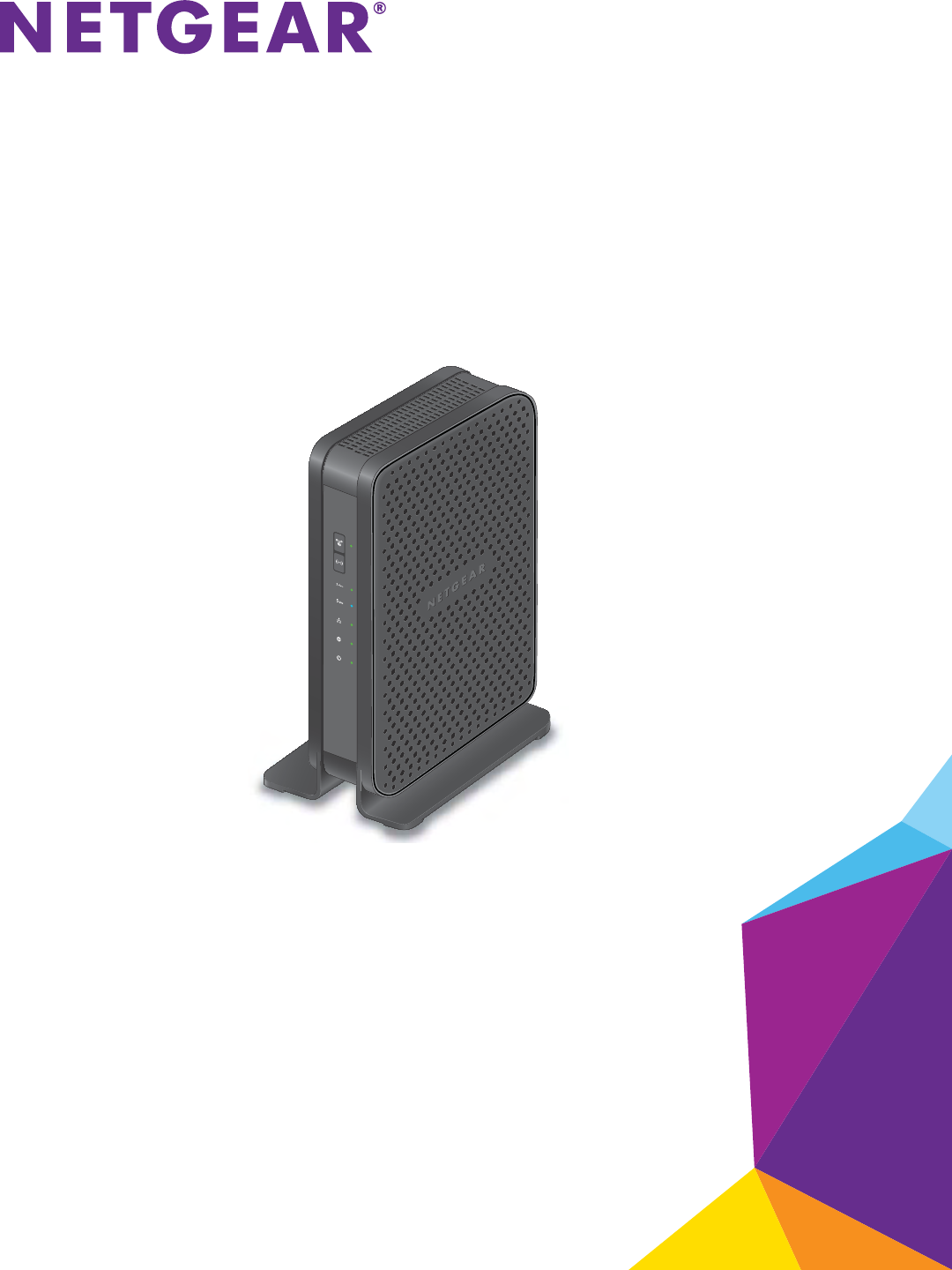
350 East Plumeria Drive
San Jose, CA 95134
USA
October 2013
202-11320-01
MoCA 2.0 N600 WiFi
Bridge/Extender WM2500RP
User Manual

2
MoCA 2.0 N600 WiFi Bridge/Extender WM2500RP
Support
Contact your Internet service provider for technical support.
Trademarks
NETGEAR, the NETGEAR logo, and Connect with Innovation are trademarks and/or registered trademarks of
NETGEAR, Inc. and/or its subsidiaries in the United States and/or other countries. Information is subject to change
without notice. © NETGEAR, Inc. All rights reserved.

3
Contents
Chapter 1 Hardware Setup
Unpack Your WiFi Bridge/Extender . . . . . . . . . . . . . . . . . . . . . . . . . . . . . . .6
Hardware Features. . . . . . . . . . . . . . . . . . . . . . . . . . . . . . . . . . . . . . . . . . . .7
Front Panel. . . . . . . . . . . . . . . . . . . . . . . . . . . . . . . . . . . . . . . . . . . . . . . .7
Back Panel . . . . . . . . . . . . . . . . . . . . . . . . . . . . . . . . . . . . . . . . . . . . . . . .9
Label. . . . . . . . . . . . . . . . . . . . . . . . . . . . . . . . . . . . . . . . . . . . . . . . . . . . 10
Position Your WiFi Bridge/Extender . . . . . . . . . . . . . . . . . . . . . . . . . . . . . .10
Cable Your WiFi Bridge/Extender. . . . . . . . . . . . . . . . . . . . . . . . . . . . . . . .11
Verify the Cabling . . . . . . . . . . . . . . . . . . . . . . . . . . . . . . . . . . . . . . . . . . . . 13
Chapter 2 Get Started with NETGEAR genie
WiFi Bridge/Extender Setup Preparation . . . . . . . . . . . . . . . . . . . . . . . . . .15
Use Standard TCP/IP Properties for DHCP . . . . . . . . . . . . . . . . . . . . . .15
Wireless Devices and Security Settings . . . . . . . . . . . . . . . . . . . . . . . . .15
Types of Logins and Access. . . . . . . . . . . . . . . . . . . . . . . . . . . . . . . . . . . .15
NETGEAR genie Setup . . . . . . . . . . . . . . . . . . . . . . . . . . . . . . . . . . . . . . .15
Use NETGEAR genie after Installation. . . . . . . . . . . . . . . . . . . . . . . . . . . .16
Upgrade WiFi Bridge/Extender Firmware. . . . . . . . . . . . . . . . . . . . . . . . . .17
Change the Password . . . . . . . . . . . . . . . . . . . . . . . . . . . . . . . . . . . . . . . .18
Add Wireless Devices or Computers to Your Network. . . . . . . . . . . . . . . .19
Manual Method. . . . . . . . . . . . . . . . . . . . . . . . . . . . . . . . . . . . . . . . . . . .19
Wi-Fi Protected Setup Method . . . . . . . . . . . . . . . . . . . . . . . . . . . . . . . .20
Chapter 3 Connections Setup
Basic Wireless Settings . . . . . . . . . . . . . . . . . . . . . . . . . . . . . . . . . . . . . . .22
WPA-PSK, WPA2-PSK, and WPA-PSK + WPA2-PSK Mixed Mode . . .25
WPA/WPA2 Enterprise. . . . . . . . . . . . . . . . . . . . . . . . . . . . . . . . . . . . . .26
WEP . . . . . . . . . . . . . . . . . . . . . . . . . . . . . . . . . . . . . . . . . . . . . . . . . . . .27
IP Address Setup . . . . . . . . . . . . . . . . . . . . . . . . . . . . . . . . . . . . . . . . . . . .28
Coax Settings . . . . . . . . . . . . . . . . . . . . . . . . . . . . . . . . . . . . . . . . . . . . . . . 30
Chapter 4 Maintenance
WiFi Bridge/Extender Status . . . . . . . . . . . . . . . . . . . . . . . . . . . . . . . . . . .33
View Network Devices . . . . . . . . . . . . . . . . . . . . . . . . . . . . . . . . . . . . . . . .36
Manage the Configuration File . . . . . . . . . . . . . . . . . . . . . . . . . . . . . . . . . .37
Back Up Settings . . . . . . . . . . . . . . . . . . . . . . . . . . . . . . . . . . . . . . . . . .37
Restore Configuration Settings. . . . . . . . . . . . . . . . . . . . . . . . . . . . . . . .38
Erase . . . . . . . . . . . . . . . . . . . . . . . . . . . . . . . . . . . . . . . . . . . . . . . . . . .38

4
MoCA 2.0 N600 WiFi Bridge/Extender WM2500RP
Upgrade the WiFi Bridge/Extender Firmware. . . . . . . . . . . . . . . . . . . . . . .39
Chapter 5 Advanced Settings
Advanced Wireless Settings. . . . . . . . . . . . . . . . . . . . . . . . . . . . . . . . . . . .42
Set Up a Wireless Schedule. . . . . . . . . . . . . . . . . . . . . . . . . . . . . . . . . . . .43
Set Up the WPS Settings . . . . . . . . . . . . . . . . . . . . . . . . . . . . . . . . . . . . . .45
Set Up a Wireless Card Access List. . . . . . . . . . . . . . . . . . . . . . . . . . . . . . 47
Chapter 6 Troubleshooting
Quick Tips . . . . . . . . . . . . . . . . . . . . . . . . . . . . . . . . . . . . . . . . . . . . . . . . .50
Sequence to Restart Your Network . . . . . . . . . . . . . . . . . . . . . . . . . . . . 50
Check Ethernet Cable Connections . . . . . . . . . . . . . . . . . . . . . . . . . . . .50
Wireless Settings . . . . . . . . . . . . . . . . . . . . . . . . . . . . . . . . . . . . . . . . . . 50
Network Settings . . . . . . . . . . . . . . . . . . . . . . . . . . . . . . . . . . . . . . . . . . 50
Troubleshoot with the LEDs . . . . . . . . . . . . . . . . . . . . . . . . . . . . . . . . . . . .51
Power LED Is Off or Blinking . . . . . . . . . . . . . . . . . . . . . . . . . . . . . . . . . 52
Power LED Stays Amber . . . . . . . . . . . . . . . . . . . . . . . . . . . . . . . . . . . . 52
All LEDs Remain Lit After Startup . . . . . . . . . . . . . . . . . . . . . . . . . . . . . 52
Internet or LAN Port LEDs Are Off . . . . . . . . . . . . . . . . . . . . . . . . . . . . . 53
WiFi LEDs are Off. . . . . . . . . . . . . . . . . . . . . . . . . . . . . . . . . . . . . . . . . . 53
WPS Button Blinks Amber . . . . . . . . . . . . . . . . . . . . . . . . . . . . . . . . . . . 53
Cannot Log In to the WiFi Bridge/Extender . . . . . . . . . . . . . . . . . . . . . . . .54
Cannot Access the Internet . . . . . . . . . . . . . . . . . . . . . . . . . . . . . . . . . . . . 54
Changes Not Saved . . . . . . . . . . . . . . . . . . . . . . . . . . . . . . . . . . . . . . . . . .55
Wireless Connectivity . . . . . . . . . . . . . . . . . . . . . . . . . . . . . . . . . . . . . . . . . 55
Appendix A Supplemental Information
Factory Settings . . . . . . . . . . . . . . . . . . . . . . . . . . . . . . . . . . . . . . . . . . . . .57
Technical Specifications. . . . . . . . . . . . . . . . . . . . . . . . . . . . . . . . . . . . . . . 58
Appendix B Notification of Compliance

5
1
1. Hardware Setup
Get to know your WiFi bridge/extender
If you have not already set up your new WiFi bridge/extender using the installation guide that
comes in the box, this chapter walks you through the hardware setup. Chapter 2, Get Started
with NETGEAR genie, explains how to set up your Internet connection.
This chapter contains the following sections:
•Unpack Your WiFi Bridge/Extender
•Hardware Features
•Position Your WiFi Bridge/Extender
•Cable Your WiFi Bridge/Extender
•Verify the Cabling
Firmware updates with new features and bug fixes are made available from time to time on
downloadcenter.netgear.com. Some products can regularly check the site and download new
firmware, or you can check for and download new firmware manually. If the features or behavior
of your product does not match what is described in this guide, you might need to update your
firmware.
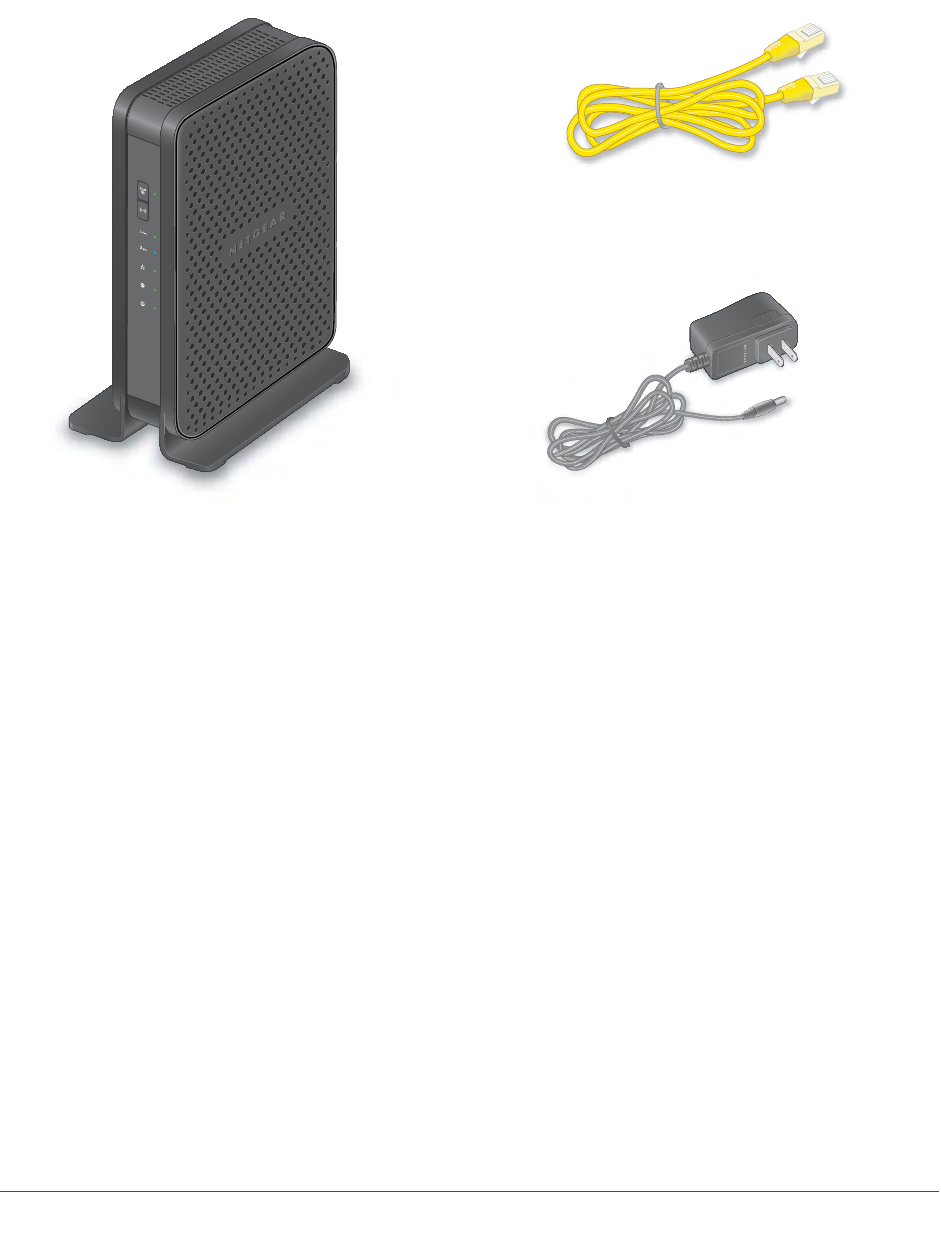
Hardware Setup
6
MoCA 2.0 N600 WiFi Bridge/Extender WM2500RP
Unpack Your WiFi Bridge/Extender
Open the box and remove the WiFi bridge/extender, cable, adapter, and installation guide.
Ethernet cable
Power adapter
MoCA WiFi Bridge/Extender
Figure 1. Package contents
Your box contains the following items:
•MoCA 2.0 N600 WiFi Bridge/Extender WM2500RP
•AC power adapter (plug varies by region)
•Category 5e (Cat 5e) Ethernet cable
•Installation guide
If any parts are incorrect, missing, or damaged, contact your NETGEAR dealer.
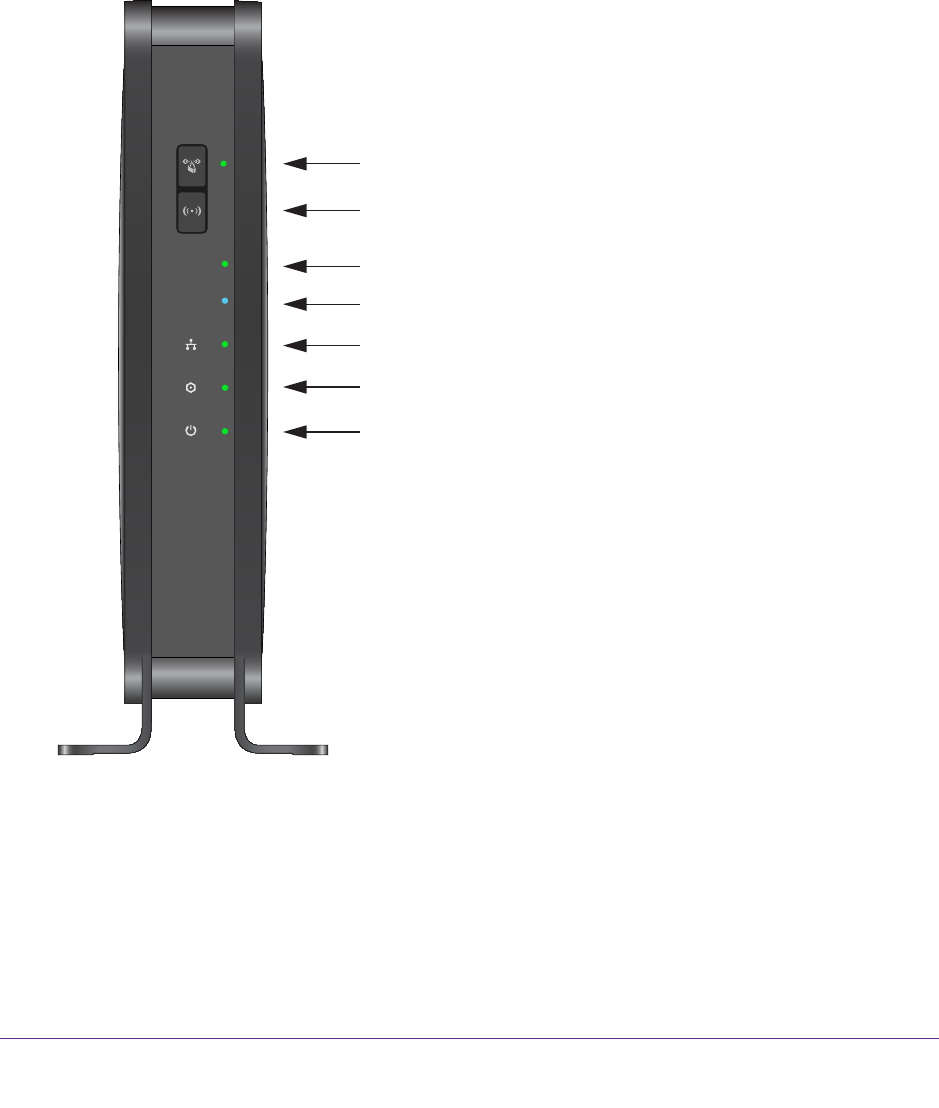
Hardware Setup
7
MoCA 2.0 N600 WiFi Bridge/Extender WM2500RP
Hardware Features
Before you cable your WiFi bridge/extender, take a moment to become familiar with the label
and the front and back panels. Pay particular attention to the LEDs on the front panel.
Front Panel
The WiFi bridge/extender front panel has the following status LEDs and buttons:
2.4
GHz
5
GHz
WPS button and LED
LAN LED
2.4 GHz WiFi LED
MoCA LED
Power LED
WiFi On/Off button
5 GHz WiFi LED
Figure 2. Front panel
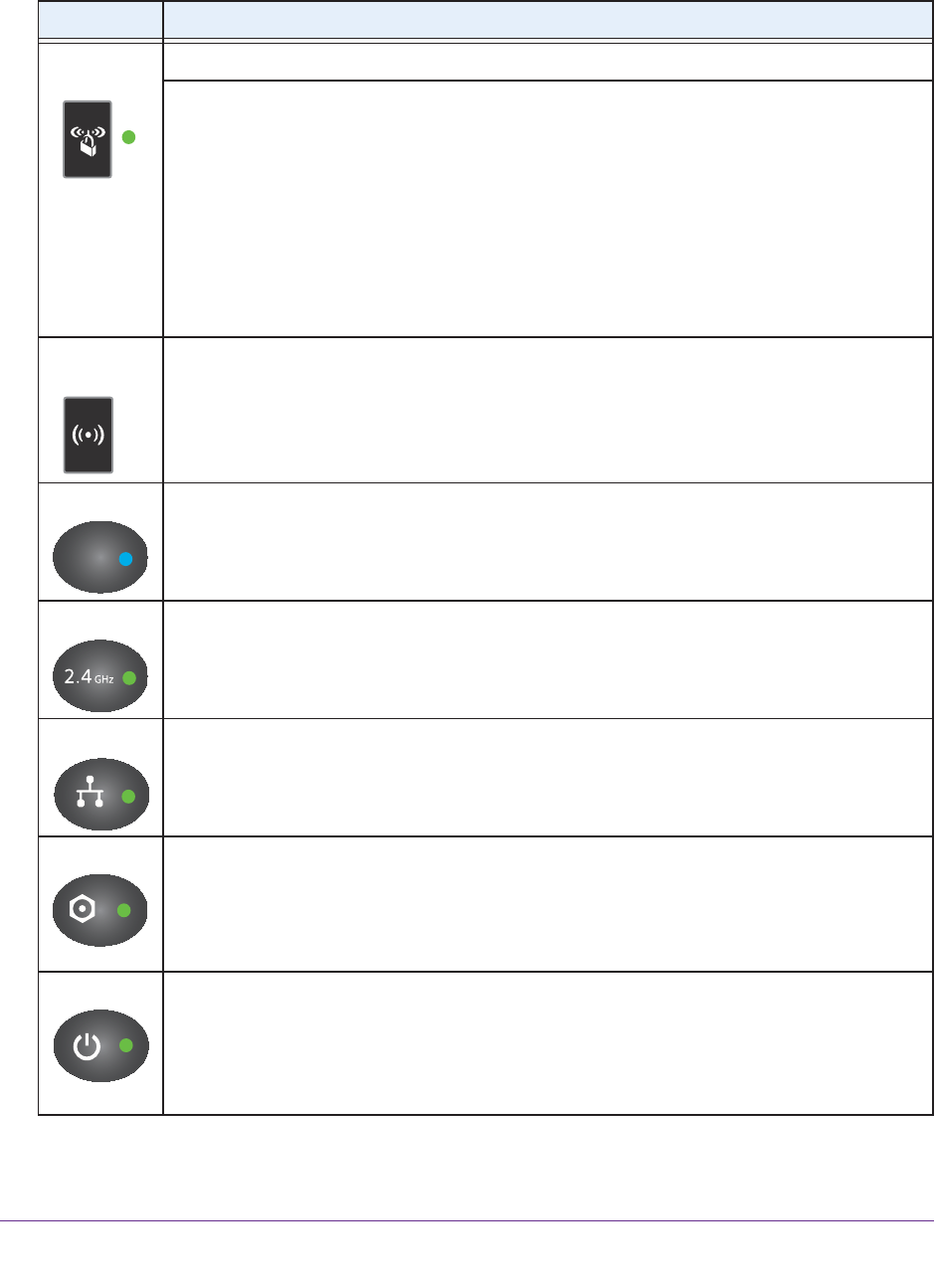
Table 1. Front panel LED and button descriptions
LED Description
WPS button
and LED
WPS button. Pressing this button initiates a WPS wireless connection procedure.
WPS LED
•Solid green. Wireless security is enabled.
•Blinking green. The WiFi bridge/extender is attempting to use WPS to add a wireless
device or computer to the wireless network.
•Blinking green rapidly for about five seconds. WPS has failed to add a wireless device
or computer.
•Blinking green rapidly and continuously. The WiFi bridge/extender is stuck in the
temporary AP setup locked state. For more information, see WPS Button Blinks Amber on
page 53.
•Off. No WPS connection exists.
WiFi On/Off
button
Pressing this button turns the wireless radios in the WiFi bridge/extender on or off.
5 GHz WiFi
5
GHz
•Solid blue. The 5 GHz wireless radio is operating.
•Off. The 5 GHz wireless radio is off.
2.4 GHz WiFi
•Solid green. The 2.4 GHz wireless radio is operating.
•Off. The 2.4 GHz wireless radio is off.
LAN •Solid green. The LAN port has detected a 100 Mbps link with an attached device.
•Solid amber. The LAN port has detected a 10 Mbps link with an attached device.
•Off. The LAN port has not detected a link with an attached device.
Online •Solid amber. The IP address was not acquired.
•Solid green. The WiFi bridge/extender received an IP address and is ready to transmit
data.
•Off. No Ethernet cable is connected between the WiFi bridge/extender and the other MoCA
device.
Power •Solid amber. The WiFi bridge/extender is starting up after being powered on.
•Solid green. The power is on, and the WiFi bridge/extender is ready.
•Blinking amber. A firmware update is in progress.
•Blinking green. The firmware is corrupt.
•Off. Power is not supplied to the WiFi bridge/extender.
Hardware Setup
8
MoCA 2.0 N600 WiFi Bridge/Extender WM2500RP
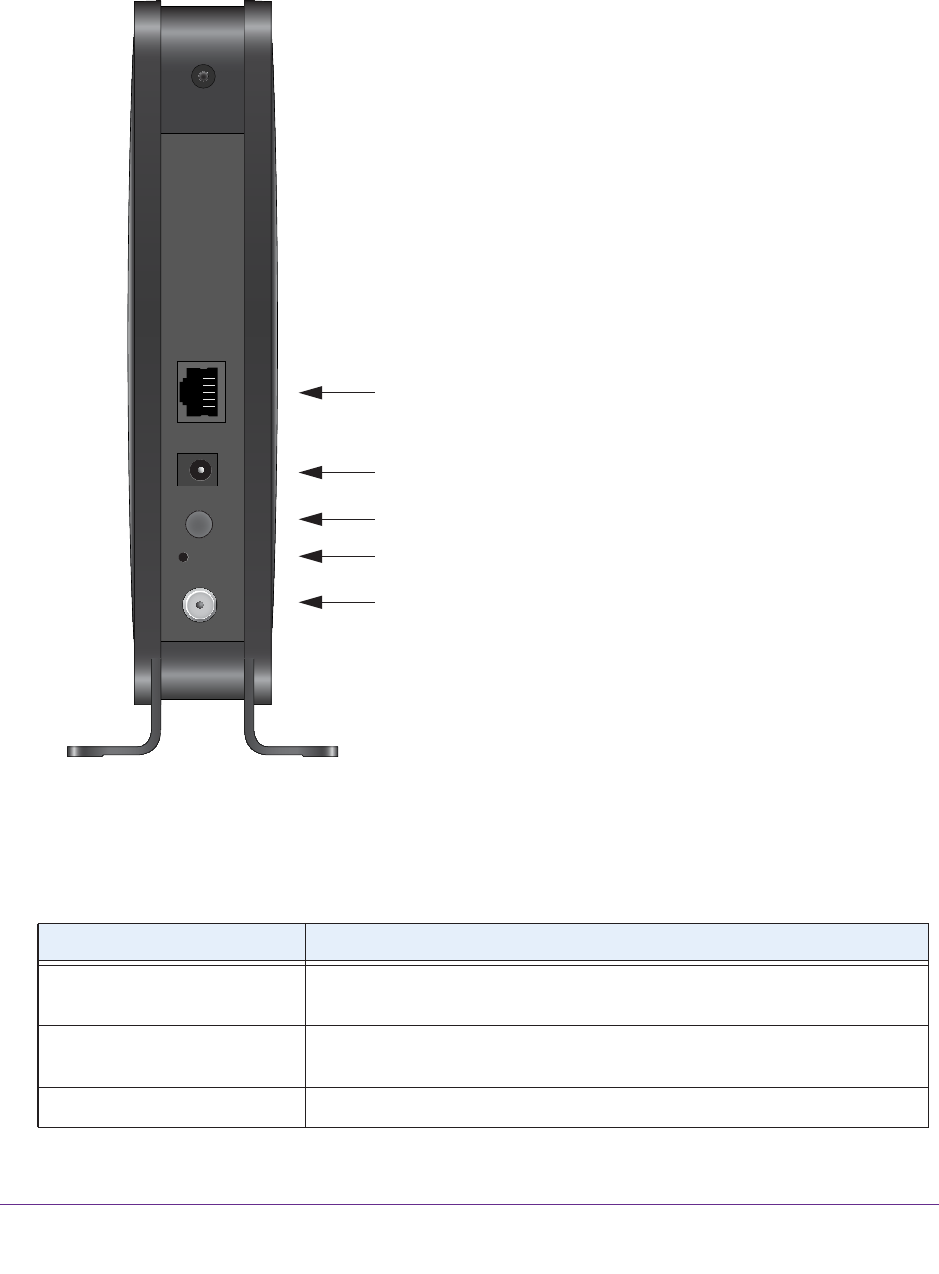
Hardware Setup
9
MoCA 2.0 N600 WiFi Bridge/Extender WM2500RP
Back Panel
The back panel has the following ports, connector, and buttons:
LAN port
Internet port
AC power connector
Power On/Off button
Reset button
Figure 3. Back panel
Table 2. Back panel port, connector, and button descriptions
Port, Connector, or Button Description
LAN port A local area network (LAN) 10/100 Mbps Ethernet port for connecting the
WiFi bridge/extender to your local computer.
AC power connector An AC power connector to connect the power adapter to the WiFi
bridge/extender.
Power On/Off button Press the Power On/Off button to power the WiFi bridge/extender on and off.
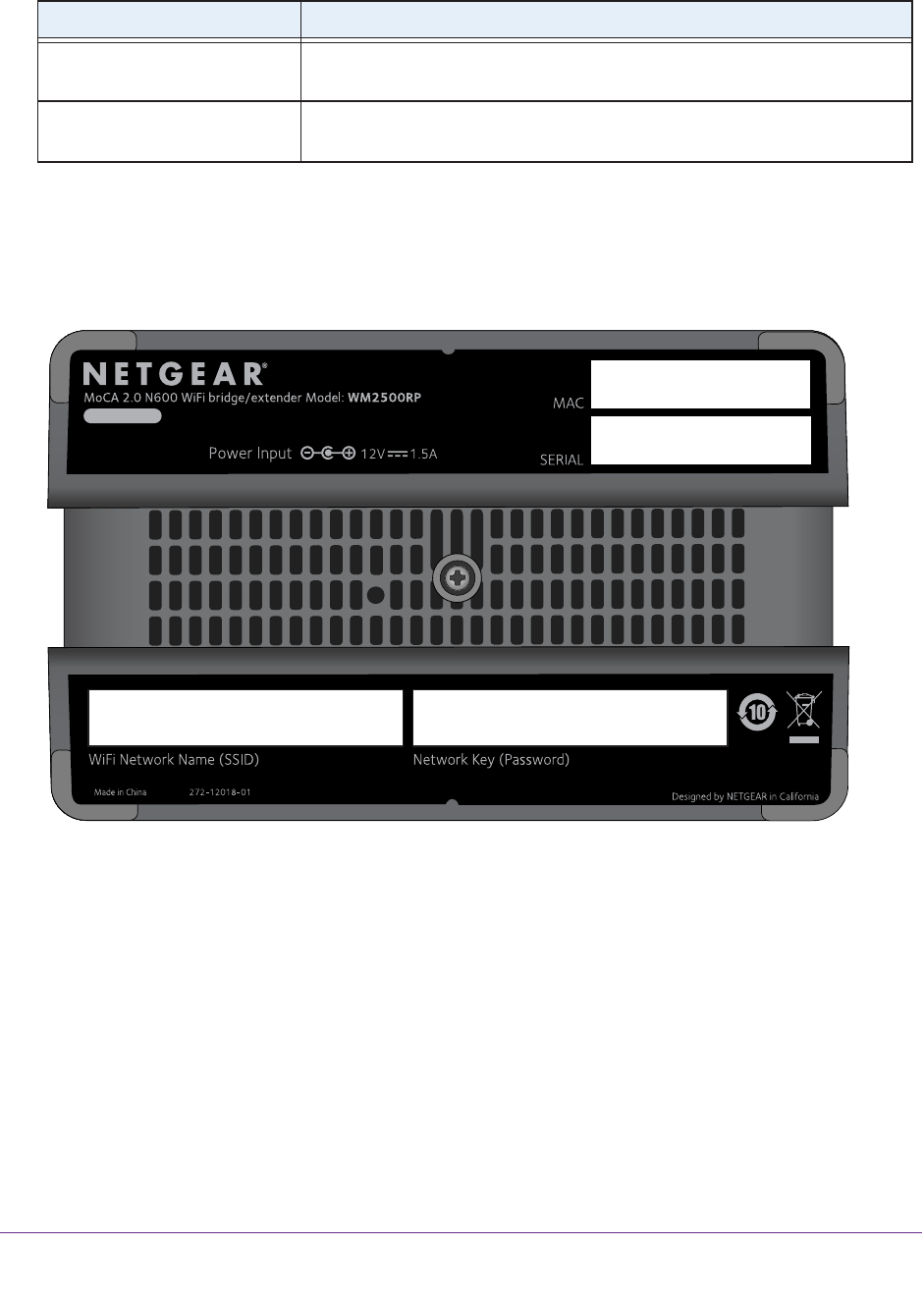
Hardware Setup
10
MoCA 2.0 N600 WiFi Bridge/Extender WM2500RP
Label
The label of the WiFi bridge/extender shows the default login information, default WiFi
network name (SSID), network key (also referred to as wireless network password or
passphrase), serial number, MAC address, and other information.
user name: admin
password: password
http://routerlogin.net
Router Login
Figure 4. Label
Position Your WiFi Bridge/Extender
The WiFi bridge/extender lets you access your network from virtually anywhere within the
operating range of your wireless network. However, the operating distance or range of your
wireless connection can vary significantly depending on the physical placement of your WiFi
bridge/extender. For example, the thickness and number of walls the wireless signal passes
through can limit the range.
To position your router:
Reset button Press the Reset button to restore the factory settings. See Factory Settings
on page 57.
Internet port A MoCA port for connecting the WiFi bridge/extender to a cable broadband
modem. The Internet port is also referred to as the WAN port.
Table 2. Back panel port, connector, and button descriptions (continued)
Port, Connector, or Button Description

Hardware Setup
11
MoCA 2.0 N600 WiFi Bridge/Extender WM2500RP
1. Place your router near the center of the area where your computers and other devices
operate, and within line of sight to your wireless devices.
2. Make sure that the router is within reach of an AC power outlet and near Ethernet cables for
wired computers.
3. Place the router in an elevated location, minimizing the number walls and ceilings between
the router and your other devices.
4. Place the router away from electrical devices such as these:
•Ceiling fans
•Home security systems
•Microwaves
•Computers
••Base of a cordless phone
•2.4 GHz cordless phone
5. Place the router away from large metal surfaces, large glass surfaces, and insulated walls
such as these:
•Solid metal door
•Aluminum studs
•Fish tanks
•Mirrors
•Brick
•Concrete
Cable Your WiFi Bridge/Extender
The installation guide that came in the box has a cabling diagram on the first page. This
section describes how to connect the WiFi bridge/extender, the computer, and the cable
broadband modem, and provides detailed illustrations.
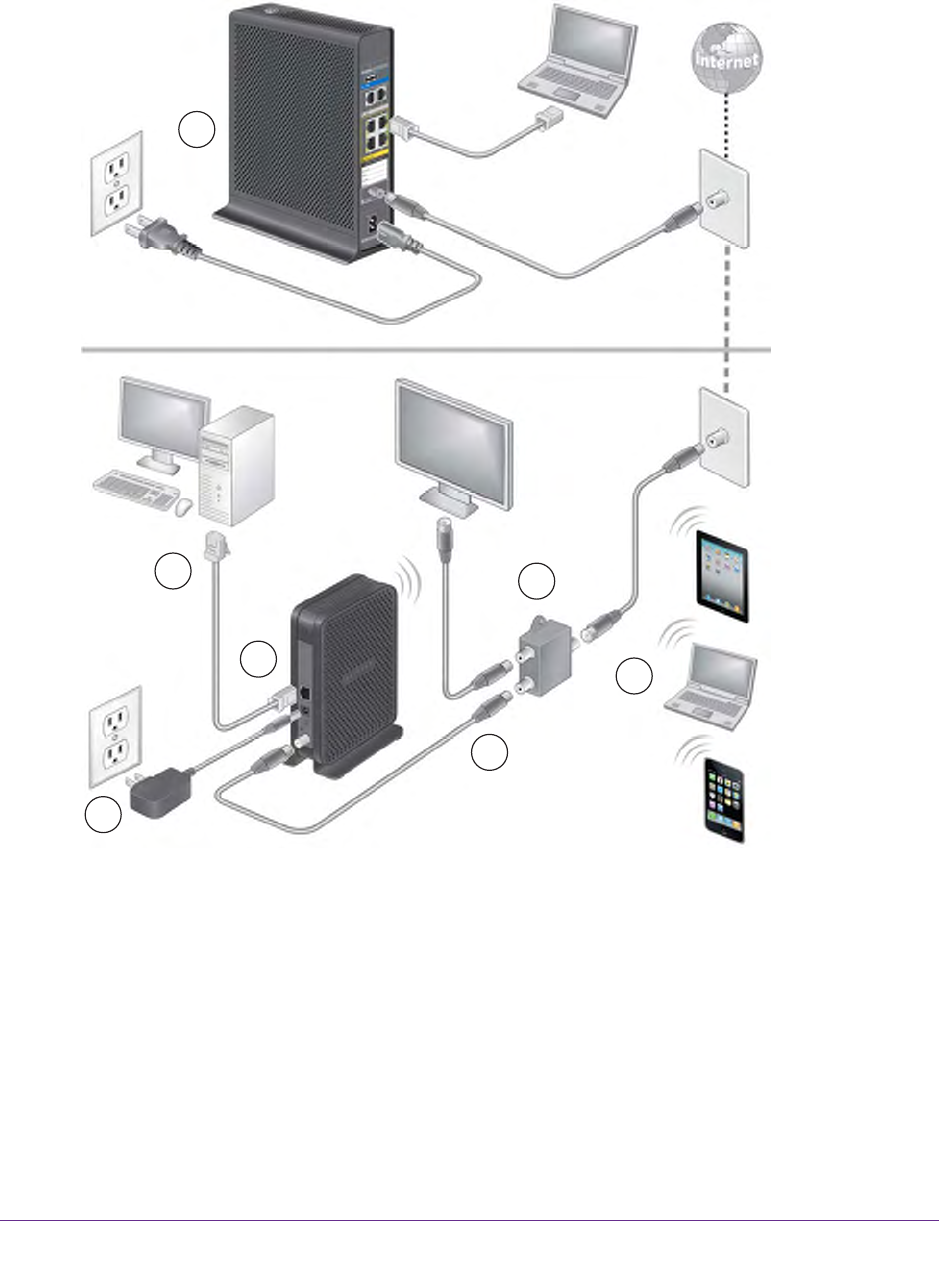
Hardware Setup
12
MoCA 2.0 N600 WiFi Bridge/Extender WM2500RP
To cable your WiFi bridge/extender:
1. Install a MoCA-capable signal splitter between the coaxial port and your existing TV (1).
1
2
3
4
5 7
6
MoCA gateway
MoCA WiFi
bridge/extender
You can skip this step if you do not have a TV or other device connected to the coaxial
port.
2. Use a coaxial cable (2) to connect the WiFi bridge/extender to the MoCA-capable signal
splitter or your coaxial port.
3. Use the Ethernet cable (3) to connect your computer to the WiFi bridge/extender.
4. Connect the power adapter (4).
5. Power on your WiFi bridge/extender (5).
The WiFi bridge/extender takes a couple of minutes to join your network.
6. After the WiFi bridge/extender joins your network, the following LEDs are lit:

Hardware Setup
13
MoCA 2.0 N600 WiFi Bridge/Extender WM2500RP
• Power LED. Solid green
• MoCA LED. Solid green
If the Power LED is not solid green, check your power adaptor connections.
If the MoCA LED is not solid green, make sure that the MoCA feature on your existing
cable router (6) is enabled. For more information, see the manual that came with your
cable router or contact your Internet service provider.
Note: The MoCA gateway is not supplied with this packaging.
7. (Optional) Connect WiFi devices (7) such as desktop computers, laptops, smart phones, and
tablets to your WiFi bridge/extender:
•You can connect these WiFi devices manually.
•You can also use the WPS (Wi-Fi Protected Setup) method.
For more information, see Add Wireless Devices or Computers to Your Network on
page 19.
Verify the Cabling
Verify that your WiFi bridge/extender is cabled correctly and that the cables are attached
securely by checking the WiFi bridge/extender LEDs:
• The Power LED is solid green when the WiFi bridge/extender is turned on.
•
5
GHz
The 5 GHz WiFi LED is solid blue.
• The 2.4 GHz WiFi LED is solid green.
• The MoCA LED is solid green.
•The LAN LED is solid green or solid amber for any computer cabled to the WiFi
bridge/extender by an Ethernet cable.

14
2
2. Get Started with NETGEAR genie
Connect to the WiFi bridge/extender
This chapter explains how to use NETGEAR genie to set up your WiFi bridge/extender after you
complete cabling as described in the installation guide and in the previous chapter in this book.
This chapter contains the following sections:
•WiFi Bridge/Extender Setup Preparation
•Types of Logins and Access
•NETGEAR genie Setup
•Use NETGEAR genie after Installation
•Upgrade WiFi Bridge/Extender Firmware
•Change the Password
•Add Wireless Devices or Computers to Your Network

Get Started with NETGEAR genie
15
MoCA 2.0 N600 WiFi Bridge/Extender WM2500RP
WiFi Bridge/Extender Setup Preparation
You can set up your WiFi bridge/extender with NETGEAR genie automatically, or you can
use the genie menus and screens to set up your WiFi bridge/extender manually.
Use Standard TCP/IP Properties for DHCP
If you set up your computer to use a static IP address, you must change the settings so that it
uses Dynamic Host Configuration Protocol (DHCP).
Wireless Devices and Security Settings
Make sure that the wireless device or computer that you are using supports WPA or WPA2
wireless security, which is the wireless security that the WiFi bridge/extender supports. For
information about the WiFi bridge/extender’s preconfigured security settings, see Basic
Wireless Settings on page 22.
Types of Logins and Access
Different types of logins have different purposes. It is important that you understand the
difference so that you know which login to use when.
•WiFi bridge/extender login. The user name admin logs you in to the WiFi
bridge/extender user interface from NETGEAR genie. For more information, see Use
NETGEAR genie after Installation on page 16.
•Wireless network login. Your WiFi bridge/extender is preset with a unique wireless
network name (SSID) and password for wireless access. This information is on the
product label.
NETGEAR genie Setup
NETGEAR genie runs on any device with a web browser. It is the easiest way to set up the
WiFi bridge/extender because it automates many of the steps and verifies that those steps
have been successfully completed. It takes about 15 minutes to complete.
To use NETGEAR genie to set up your WiFi bridge/extender:
1. Connect the router to a power source.
2. Make sure that your device is connected with an Ethernet cable to your WiFi
bridge/extender.
3. Launch your Internet browser in one of the following ways:
•If you are setting up the Internet connection for your WiFi bridge/extender for the first
time, the browser automatically goes to http://www.routerlogin.net, and the
NETGEAR genie screen displays.
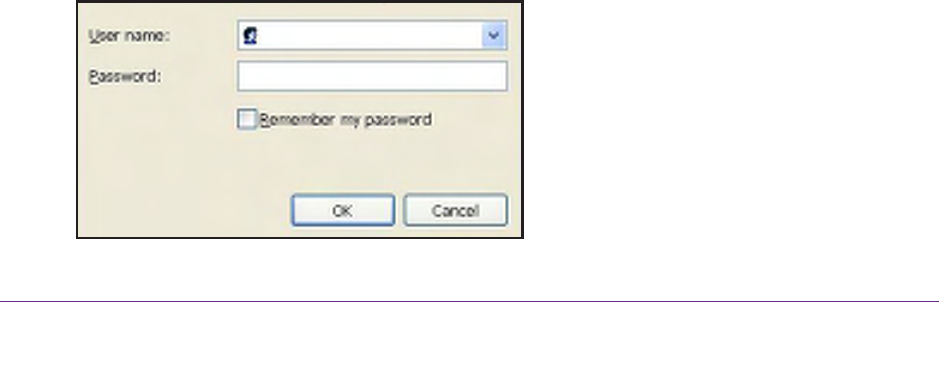
Get Started with NETGEAR genie
16
MoCA 2.0 N600 WiFi Bridge/Extender WM2500RP
•If you already used NETGEAR genie, type http://www.routerlogin.net in the
address field for your browser to display the NETGEAR genie screen. For more
information, see Use NETGEAR genie after Installation on page 16.
4. Follow the onscreen instructions to complete the NETGEAR genie setup.
NETGEAR genie guides you through connecting the WiFi bridge/extender to the Internet.
5. If the browser cannot display the web page, do the following:
•Make sure that the computer is connected to the LAN Ethernet port or wirelessly to
the WiFi bridge/extender.
•Make sure that the WiFi bridge/extender is running. If it is, its WiFi LEDs are lit.
•Close and reopen the browser to make sure that the browser does not cache the
previous page.
•Browse to http://routerlogin.net.
•If the computer is set to a static or fixed IP address (this situation is uncommon),
change it to obtain an IP address automatically from the WiFi bridge/extender.
6. If the WiFi bridge/extender does not connect to the Internet, do the following:
a. To be sure that you have selected the correct options and typed everything correctly,
review the WiFi bridge/extender’s settings.
b. Contact your ISP to verify that you have the correct configuration information for
your main Internet connection.
c. Read Chapter 6, Troubleshooting.
Use NETGEAR genie after Installation
When you first set up your WiFi bridge/extender, NETGEAR genie automatically starts when
you launch an Internet browser on a computer that is connected to the WiFi bridge/extender.
To use NETGEAR genie again to view or change settings:
1. Launch your browser from a computer or wireless device that is connected to the WiFi
bridge/extender.
2. Enter http://www.routerlogin.net or http://www.routerlogin.com in the web browser
address bar.
A login screen displays.
admin
********
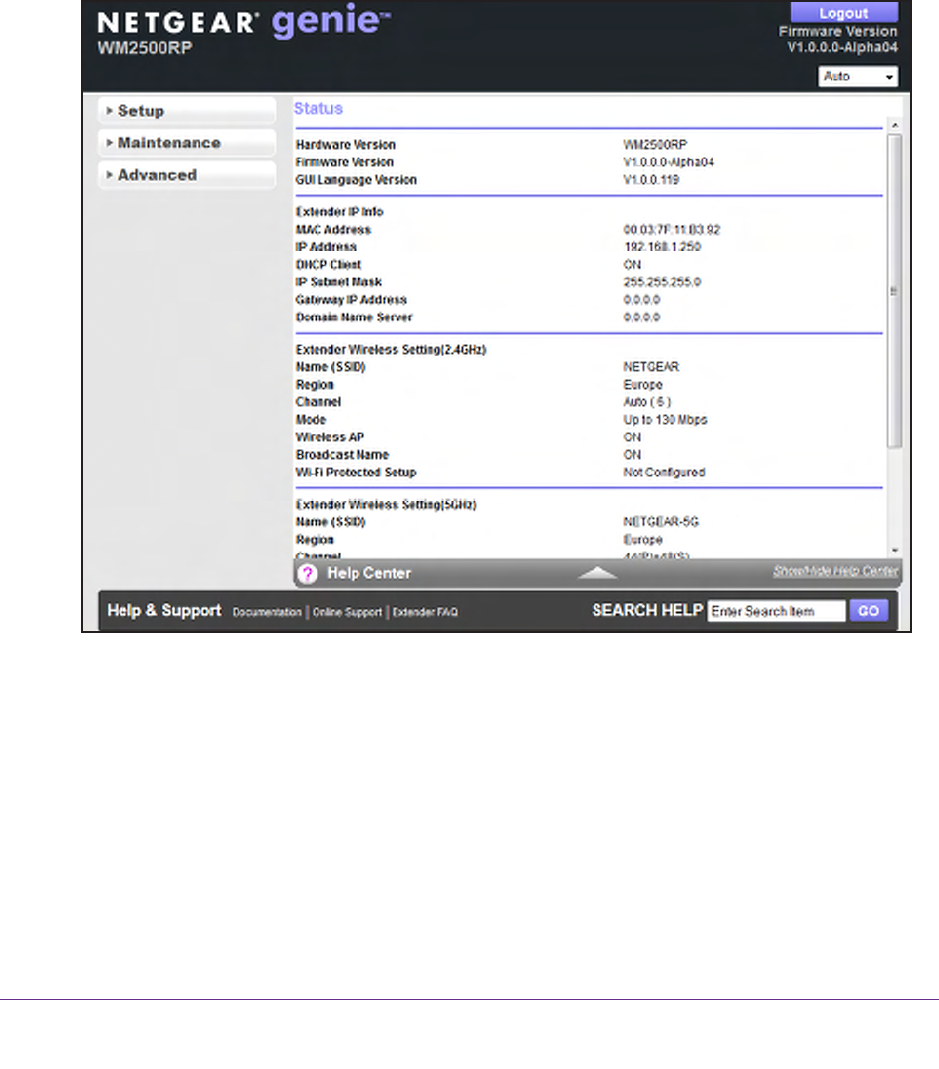
Get Started with NETGEAR genie
17
MoCA 2.0 N600 WiFi Bridge/Extender WM2500RP
3. Enter the WiFi bridge/extender user name and password.
The user name is admin. The default password is password. The user name and
password are case-sensitive.
Note: The WiFi bridge/extender user name and password are different from
the user name and password for logging in to your Internet connection. For
more information, see Types of Logins and Access on page 15.
4. Click the OK button.
5. The Status screen displays.
Upgrade WiFi Bridge/Extender Firmware
When you set up your WiFi bridge/extender and are connected to the Internet, the WiFi
bridge/extender automatically checks for you to see if newer firmware is available. If it is, a
message is displayed on the top of the screen. The message might be A router firmware
upgrade is available, or a similar message.
To upgrade the firmware after the WiFi bridge/extender has detected newer firmware
and displays a message:
1. Click the message.

Get Started with NETGEAR genie
18
MoCA 2.0 N600 WiFi Bridge/Extender WM2500RP
The Firmware Upgrade Assistant displays.
2. Click the Yes button.
The WiFi bridge/extender upgrades to the latest firmware. After the upgrade, the WiFi
bridge/extender restarts.
CAUTION:
Do not try to go online, turn off the WiFi bridge/extender, shut down the
computer, or do anything else to the WiFi bridge/extender until the WiFi
bridge/extender finishes restarting and the Power LED has been solid
green for several seconds.
For more information about upgrading firmware, see Upgrade the WiFi Bridge/Extender
Firmware on page 39.
Change the Password
The default password that you use to log in to the WiFi bridge/extender is password. Best
practice is that you change this default password to a secure password.
Changing the default password is not the same as changing the password for wireless
access. The label on your WiFi bridge/extender shows your unique wireless network name
(SSID) and the passphrase (also referred to as the wireless network password or network
key) for wireless access (see Label on page 10).
To change the default password that you use to log in to the WiFi bridge/extender:
1. Log in to the WiFi bridge/extender.
For more information, see Use NETGEAR genie after Installation on page 16.
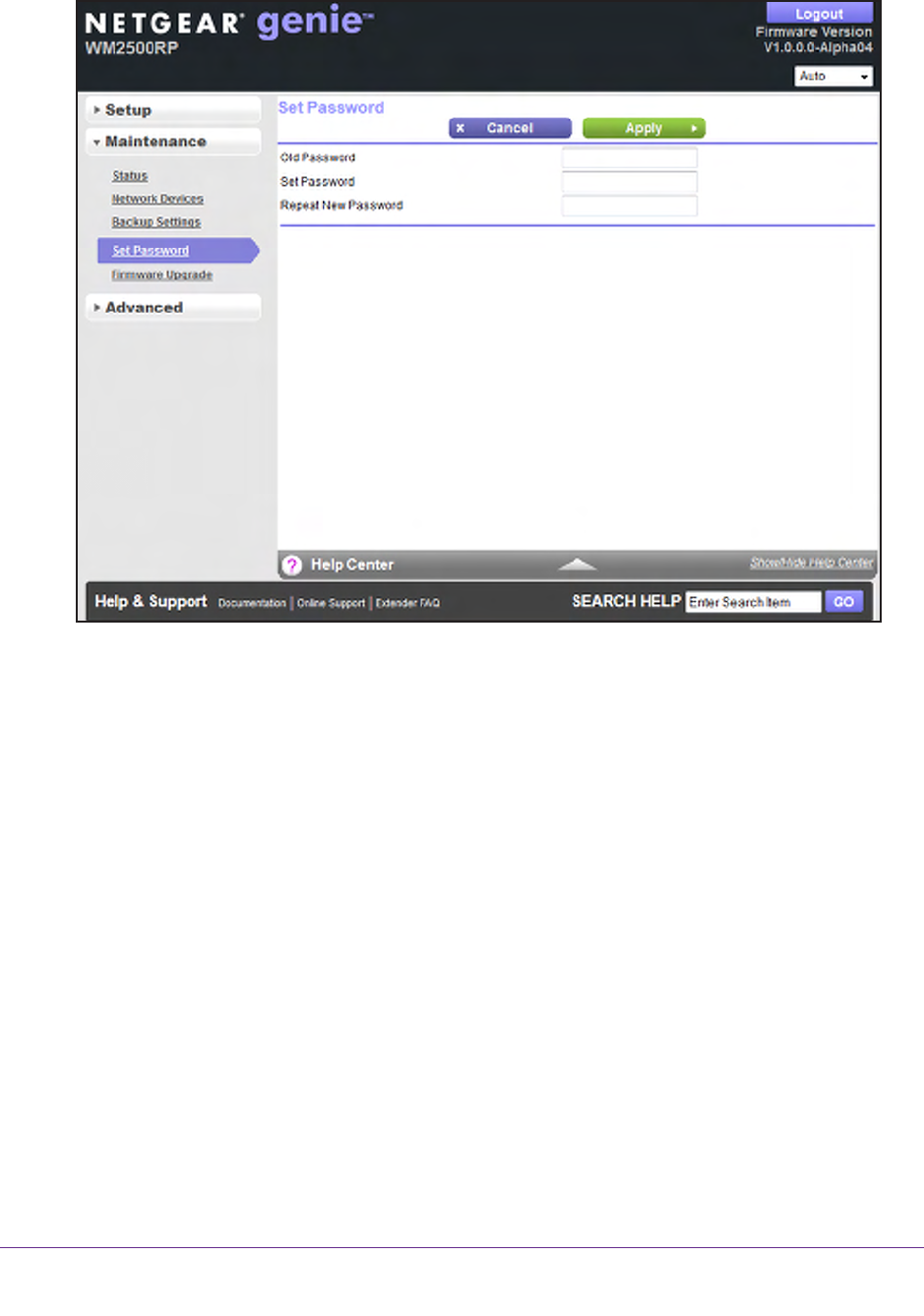
Get Started with NETGEAR genie
19
MoCA 2.0 N600 WiFi Bridge/Extender WM2500RP
2. Select Maintenance > Set Password.
3. Type the old password and type the new password twice.
4. Click the Apply button.
Add Wireless Devices or Computers to Your Network
Choose either the manual or the WPS method to add wireless devices and other equipment
to your wireless network.
Manual Method
To connect manually:
1. Open the software that manages your wireless connections on the wireless device
(laptop computer, gaming device, smart phone) that you want to connect to your WiFi
bridge/extender.
The wireless software scans for all wireless networks in your area.
2. Look for your network and select it. If you did not change the name of your network during
the setup process, look for the default WiFi network name (SSID) and select it.
The default SSID is on the WiFi bridge/extender’s product label.

Get Started with NETGEAR genie
20
MoCA 2.0 N600 WiFi Bridge/Extender WM2500RP
3. Enter the WiFi bridge/extender wireless network password (passphrase) and click the
Connect button.
The default WiFi bridge/extender passphrase is on the WiFi bridge/extender’s product
label.
4. Repeat Steps 1–3 to add other wireless devices.
Wi-Fi Protected Setup Method
Wi-Fi Protected Setup (WPS) lets you connect to a secure WiFi network without typing its
password. Instead, press a button. NETGEAR calls WPS Push 'N' Connect.
During the connection process, the client gets the security settings from the WiFi
bridge/extender so that every device in the network has the same security settings.
Some older WiFi equipment is not compatible with WPS. WPS works only with WPA2 or WPA
wireless security.
To use WPS to join the wireless network:
1. Press the WPS button on the WiFi bridge/extender front panel.
The WPS LED (on the button) starts to blink green.
2. Within two minutes, press the WPS button on your wireless device or follow the WPS
instructions that came with the device.
The device is now connected to your WiFi bridge/extender.
3. Repeat Steps 1–2 to add other WPS wireless devices.

Connections Setup
22
MoCA 2.0 N600 WiFi Bridge/Extender WM2500RP
Basic Wireless Settings
You can view or configure the wireless network setup.
The WiFi bridge/extender comes with preset WPA2-PSK security. This means that the WiFi
network name (SSID), wireless network password (also referred to as the passphrase or
network key), and security option (authentication and encryption protocol) are preset in the
factory. You can find the preset SSID and password on the WiFi bridge/extender label. The
preset SSID and password are uniquely generated for every device to protect and maximize
your wireless security.
WARNING:
Best practice is not to change your preset security settings. If you
do decide to change your preset security settings, make a note of
the new settings and store it in a safe place where you can easily
find it.
Note: If you use a wireless computer to change the SSID or other wireless
security settings, you are disconnected when you click the Apply
button. To avoid this situation, use a computer with a wired
connection to access the WiFi bridge/extender.
To view or change basic wireless settings:
1. Log in to the WiFi bridge/extender.
For more information, see Use NETGEAR genie after Installation on page 16.
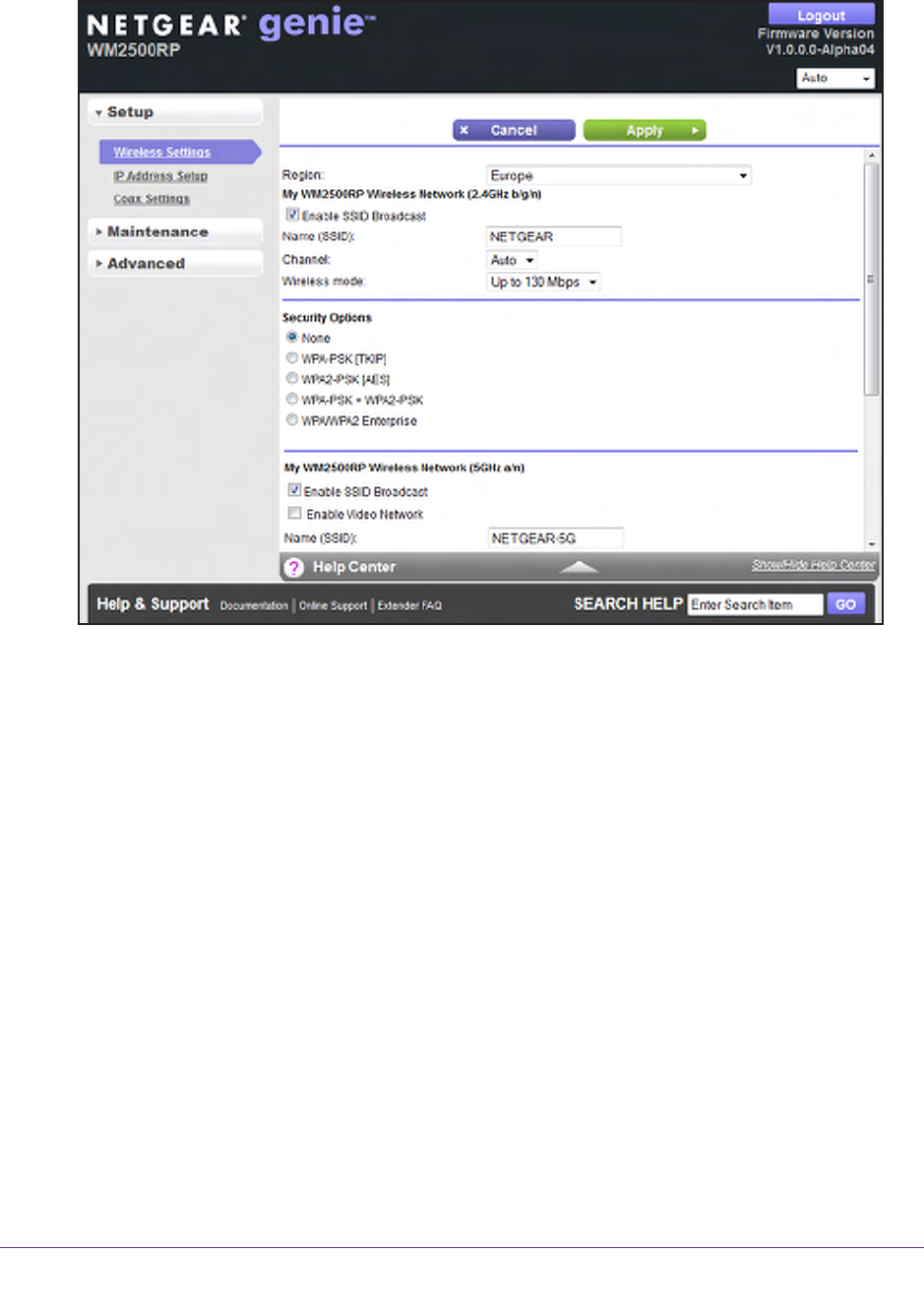
Connections Setup
23
MoCA 2.0 N600 WiFi Bridge/Extender WM2500RP
2. Select Setup > Wireless Settings.
The 2.4 GHz and 5 GHz WiFi bands are configured separately.
3. To specify the location where the WiFi bridge/extender is used, select from the countries in
the Region list.
In the United States, the region is fixed to United States and is not changeable.
4. To enable SSID broadcast, select the Enable SSID Broadcast check box.
This feature allows the WiFi bridge/extender to broadcast its SSID so wireless stations
can see this wireless name (SSID) in their scanned network lists. This check box is
selected by default, but you can clear it to disable broadcast of the SSID.
5. Enter the SSID in the Name (SSID) field.
The SSID is also known as the wireless network name. The default SSID is randomly
generated. Best practice is that you do not change the default SSID. If you do decide
to change the name, enter a 32-character (maximum) name in this field. This field is
case-sensitive.
6. Select the channel from the Channel list.
This setting is the wireless channel used by the gateway. For the 2.4 GHz band, select
either Auto or a value from 1 through 13. For products in the North America market, only
Channels 1 through 11 can be operated. Do not change the channel unless you
experience interference (shown by lost connections or slow data transfers). If this

Connections Setup
24
MoCA 2.0 N600 WiFi Bridge/Extender WM2500RP
happens, experiment with different channels to see which is the best. The default setting
is Auto, which means that the WiFi bridge/extender selects a channel automatically.
Note: When you use multiple access points, it is better if adjacent access
points use different channels to reduce interference. In the 2.4 GHz band, the
recommended channel spacing between adjacent access points is five
channels (for example, use Channels 1 and 6, or 6 and 11).
7. Select the mode from the Wireless mode list.
Mode. Up to 150 Mbps is the default setting. Up to 54 Mbps supports 802.11g and 11b
wireless devices. The 300 Mbps setting allows 802.11n devices to connect at this speed.
8. Specify the security option:
You can change the wireless authentication and encryption option and the passphrase
(also referred to as the wireless network password or network key). The security that you
select encrypts data transmissions and ensures that only trusted devices receive
authorization to connect to your network.
WARNING:
Best practice is that you do not change the wireless security
option or the passphrase. Do not disable wireless security!
•To set up WPA-PSK, WPA2-PSK, or WPA-PSK + WPA2-PSK mixed mode security,
see WPA-PSK, WPA2-PSK, and WPA-PSK + WPA2-PSK Mixed Mode on page 25.
•To set up WPA/WPA2 enterprise security, see WPA/WPA2 Enterprise on page 26.
•To set up WEP security, see WEP on page 27.
9. Click the Apply button.
10. Set up and test your wireless devices and computers to make sure that they can connect
wirelessly. If they do not, check the following:
•Is your wireless device or computer connected to your network or another wireless
network in your area? Some wireless devices automatically connect to the first open
network (without wireless security) that they discover.
•Does your wireless device or computer display on the Attached Devices screen? If it
does, then it is connected to the network.
•If you are not sure what the SSID or password is, look on the label on your WiFi
bridge/extender.
Note: The WEP option displays only if you select Up to 54 Mbps from the
Mode list.
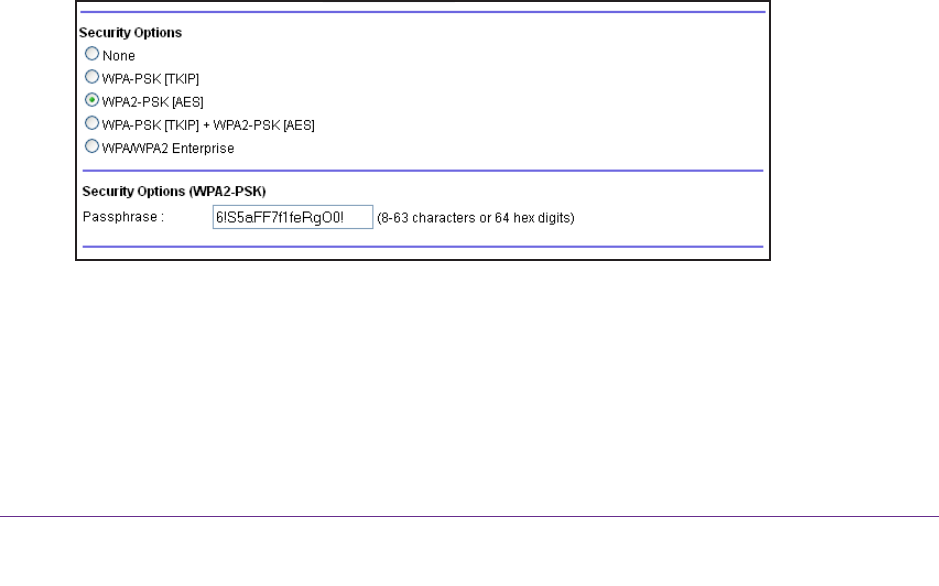
Connections Setup
25
MoCA 2.0 N600 WiFi Bridge/Extender WM2500RP
WPA-PSK, WPA2-PSK, and WPA-PSK + WPA2-PSK Mixed
Mode
These types of wireless security options use a pre-shared key (PSK), which is the same as a
passphrase, wireless network password, or network key.
You can select from the following wireless PSK security options:
•WPA-PSK [TKIP]. Wi-Fi Protected Access (WPA) data encryption provides strong data
security with Temporal Key Integrity Protocol (TKIP) encryption. This option supports
speeds of up to 54 Mbps only.
•WPA2-PSK [AES]. Wi-Fi Protected Access version 2 (WPA2) data encryption provides
strong data security with Advanced Encryption Standard (AES) encryption. This setting is
the preset wireless security that is enabled by default. WPA2 provides the most reliable
security. This option supports speeds of up to 300 Mbps. If not all clients in your network
support WPA2, select WPA-PSK + WPA2-PSK mixed mode.
•WPA-PSK [TKIP] + WPA2-PSK [AES]. WPA-PSK + WPA2-PSK is referred to as mixed
mode, which supports a combination of TKIP and AES encryption for both WPA and
WPA2 clients. For WPA clients, this option supports speeds of up to 54 Mbps only. For
WPA2 clients, this option supports speeds of up to 300 Mbps.
•WPA/WPA2 Enterprise. This security option is not for home use but is typically used in a
business or enterprise. For more information, see WPA/WPA2 Enterprise on page 26.
To change the WPA wireless security option and passphrase:
1. Log in to the WiFi bridge/extender.
For more information, see Use NETGEAR genie after Installation on page 16.
2. Select Setup > Wireless Settings.
3. In the Security Options section, select one of the WPA options with PSK.
4. In the associated Passphrase field, enter the passphrase that you want to use.
The passphrase is a text string from 8 to 63 ASCII characters or exactly 64 hexadecimal
digits. A hexadecimal digit is one of the following characters: 0, 1, 2, 3, 4, 5, 6, 7, 8, 9,
A–F, or a–f.
Wireless clients need to use the passphrase to access the wireless network through the
WiFi bridge/extender.
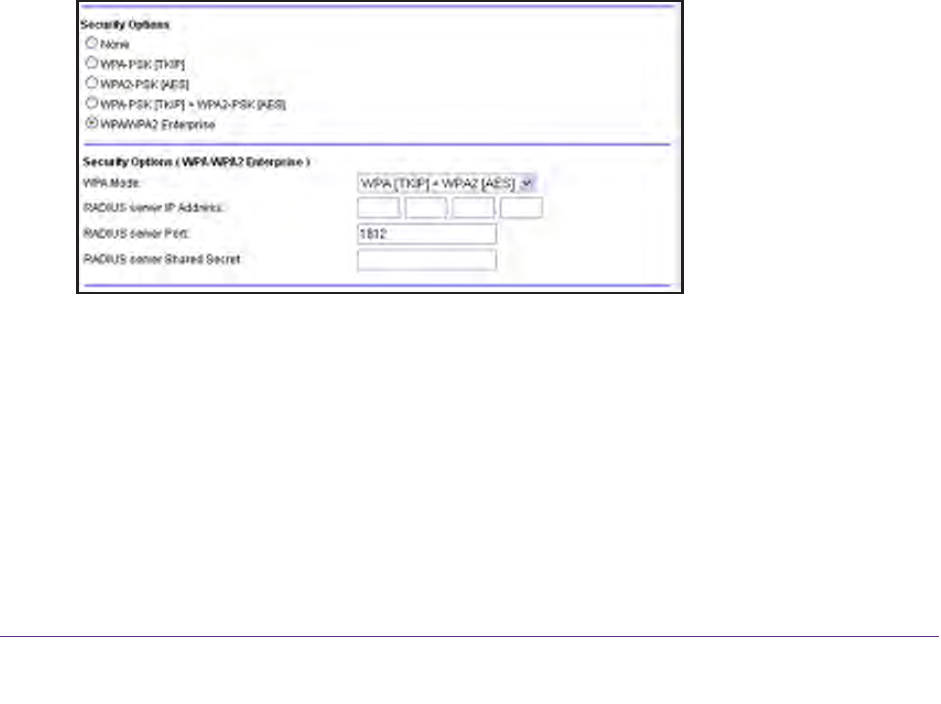
Connections Setup
26
MoCA 2.0 N600 WiFi Bridge/Extender WM2500RP
5. Click the Apply button.
WPA/WPA2 Enterprise
This security option is not for home use but is typically used in a business or enterprise.
WPA/WPA2 Enterprise does not use a passphrase but supports 802.1x authentication, which
requires an internal or external RADIUS server. A Remote Authentication Dial In User
Service (RADIUS) server provides Authentication, Authorization, and Accounting (AAA)
management to grant (or deny) computers access to your wireless network.
WPA/WPA2 Enterprise can support WPA [TKIP] for WPA clients only, WPA2 [AES] for WPA2
clients only, and WPA [TKIP] + WPA2 [AES]. WPA [TKIP] + WPA2 [AES] is a combination of
TKIP and AES encryption for both WPA and WPA2 clients. WPA clients are supported at
speeds of up to 54 Mbps only. WPA2 clients are supported at speeds of up 300 Mbps.
WPA/WPA2 Enterprise supports five Extensible Authentication Protocol (EAP) authentication
methods: EAP-TLS, EAP-TTLS/MSCHAPv2, PEAPv0/EAP-MSCHAPv2, PEAPv1/EAP-GTC,
and EAP-SIM.
To configure WPA/WPA2 Enterprise security:
1. Log in to the WiFi bridge/extender.
For more information, see Use NETGEAR genie after Installation on page 16.
2. Select Setup > Wireless Settings.
3. In the Security Options section, select the WPA/WPA2 Enterprise radio button.
4. Select the WPA mode (WPA [TKIP], WPA2 [AES], or WPA [TKIP] + WPA2 [AES]).
5. Type the IP address of the RADIUS server.
The address can be on your LAN or it can be an external address.
6. Enter the port number for the RADIUS server in the range from 1 to 65535.
The default number is 1812.
7. Type the shared secret, which must be from 1 through 128 characters (the default value
is blank).
The shared secret is case-sensitive.
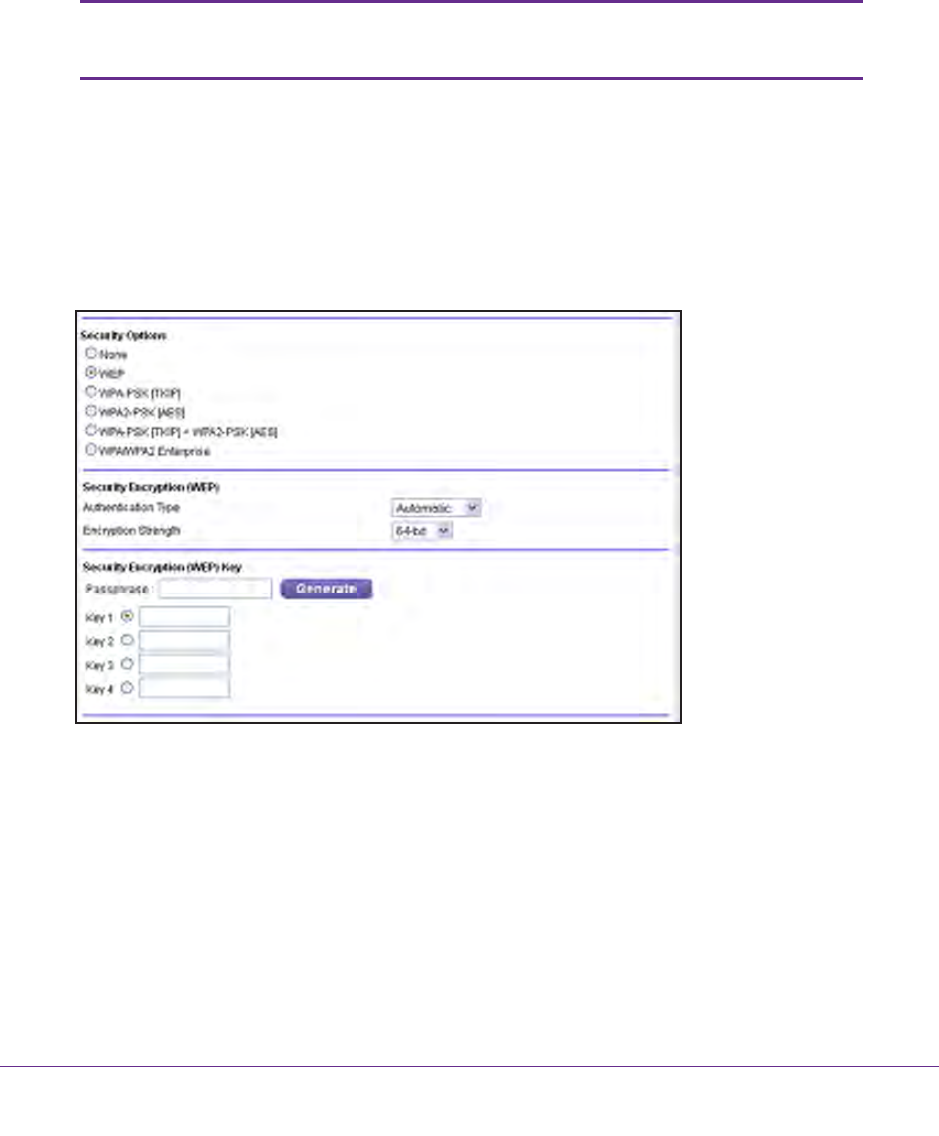
Connections Setup
27
MoCA 2.0 N600 WiFi Bridge/Extender WM2500RP
8. Click the Apply button.
WEP
Wired Equivalent Privacy (WEP) security is an authentication and data encryption mode that
is superseded by WPA-PSK and WPA2-PSK. WEP supports speeds of up to 54 Mbps and
does not function with WPS.
Note: The WEP option displays only if you select Up to 54 Mbps from the
Mode list.
To configure WEP security:
1. Log in to the WiFi bridge/extender.
For more information, see Use NETGEAR genie after Installation on page 16.
2. Select Setup > Wireless Settings.
3. In the Security Options section, select the WEP radio button.
4. In the Authentication Type list, select one of the following types:
•Automatic. If you enter a passphrase in the Passphrase field and click the Generate
button, the four keys are automatically generated.
•Shared Key. If you select this option, you must select one key and enter the value
manually.
5. In the Encryption Strength list, select the encryption key size:
•64-bit. Standard WEP encryption, using 40/64-bit encryption.
•128-bit. Standard WEP encryption, using 104/128-bit encryption. This selection
provides higher encryption security.

Connections Setup
28
MoCA 2.0 N600 WiFi Bridge/Extender WM2500RP
6. Depending on the authentication type, generate the key automatically or enter it manually:
•If the authentication type is Automatic:
a. In the Passphrase field, enter a passphrase:
b. Click the Generate button.
For 64-bit WEP, four different WEP keys are generated. For 128-bit WEP, only
one WEP key is generated, and the four key fields are populated with the same
WEP key.
•If the authentication type is Shared Key:
a. Specify the active key by selecting the Key 1, Key 2, Key 3, or Key 4 radio
button.
b. Enter the value for the key manually:
- For 64-bit WEP, enter 10 hexadecimal digits (any combination of 0–9, A–F).
The key values are not case-sensitive.
- For 128-bit WEP, enter 26 hexadecimal digits (any combination of 0–9, A–F).
The key values are not case-sensitive.
7. Click the Apply button.
IP Address Setup
You can view or change ISP information. The default settings usually work fine.
To view or change the IP address setup:
1. Log in to the WiFi bridge/extender.
For more information, see Use NETGEAR genie after Installation on page 16.
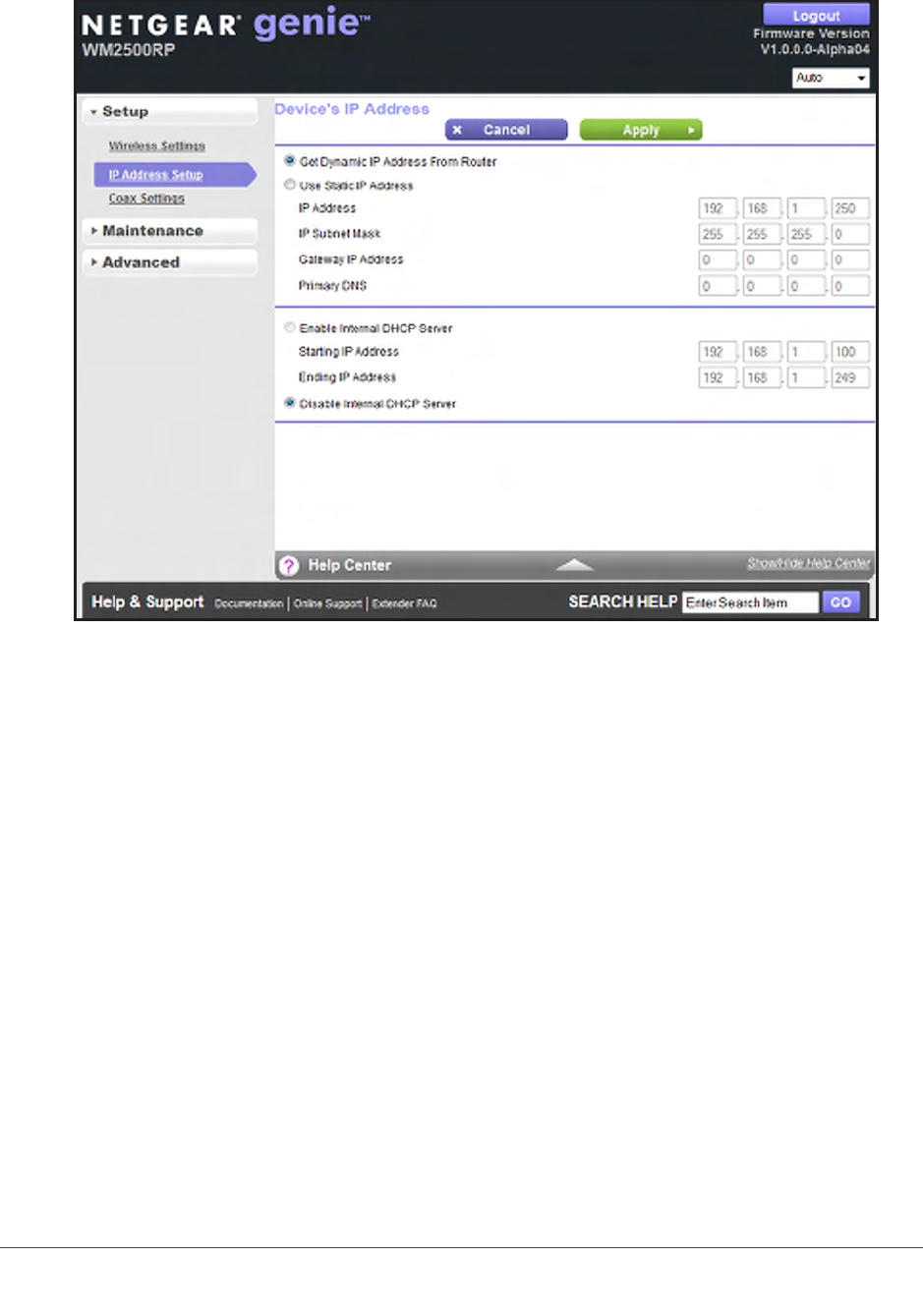
Connections Setup
29
MoCA 2.0 N600 WiFi Bridge/Extender WM2500RP
2. Select Setup > IP Address Setup.
3. Enter the following settings for the IP address and DNS server:
•Internet IP Address:
- Get Dynamically from ISP. Your ISP uses DHCP to assign your IP address. Your
ISP automatically assigns these addresses.
- Use Static IP Address. Enter the IP address, IP subnet mask, and the gateway IP
address that your ISP assigned to you. The gateway is the ISP router to which
your WiFi bridge/extender should connect.
•Domain Name Server (DNS) Address. The DNS server is used to look up site
addresses based on their names. Select one of the following radio buttons:
- Get Automatically from ISP. Your ISP uses DHCP to assign your DNS servers.
Your ISP automatically assigns these IP addresses.
- Use These DNS Servers. If you know that your ISP does not automatically
transmit DNS addresses to the WiFi bridge/extender during login, select this radio
button, and enter the IP address of your ISP primary DNS server. If a secondary
DNS server address is available, enter it also.
4. Click the Apply button.
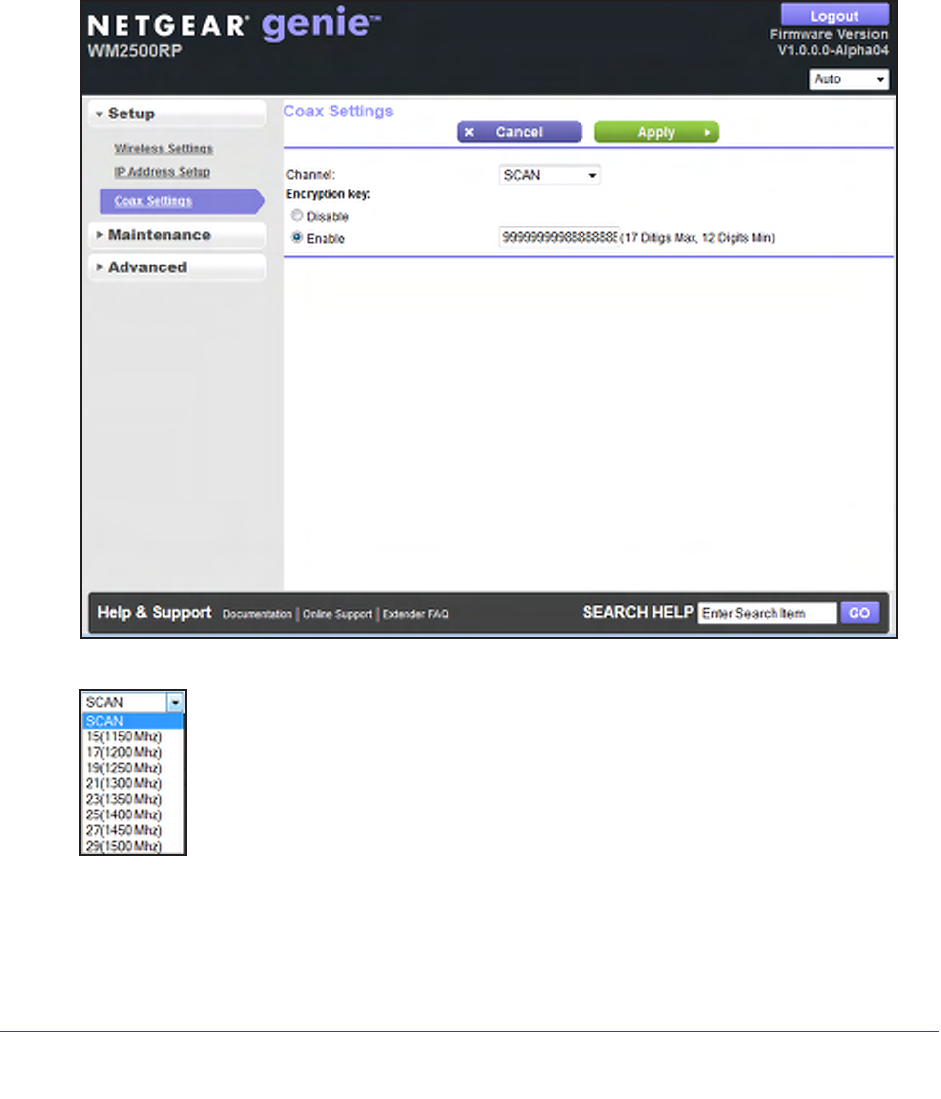
Connections Setup
30
MoCA 2.0 N600 WiFi Bridge/Extender WM2500RP
Coax Settings
You can view or change the coax settings.
To view or change the coax settings:
1. Log in to the WiFi bridge/extender.
For more information, see Use NETGEAR genie after Installation on page 16.
2. Select Setup > Coax Settings.
3. From the Channel list, select the channel that you want to use.
4. To enable the encryption key, in the Encryption key section, select the Enable radio button.
If the encryption key feature is enabled, the key used by the WiFi bridge/extender and
cable MoCA gateway must match.

Connections Setup
31
MoCA 2.0 N600 WiFi Bridge/Extender WM2500RP
5. Click the Apply button.
Your settings are saved.

32
4
4. Maintenance
Manage your network
This chapter describes the WiFi bridge/extender settings for administering and maintaining your
WiFi bridge/extender and home network. The chapter includes the following sections:
•WiFi Bridge/Extender Status
•View Network Devices
•Manage the Configuration File
•Upgrade the WiFi Bridge/Extender Firmware
For information about changing the password of your WiFi bridge/extender, see Change the
Password on page 18.
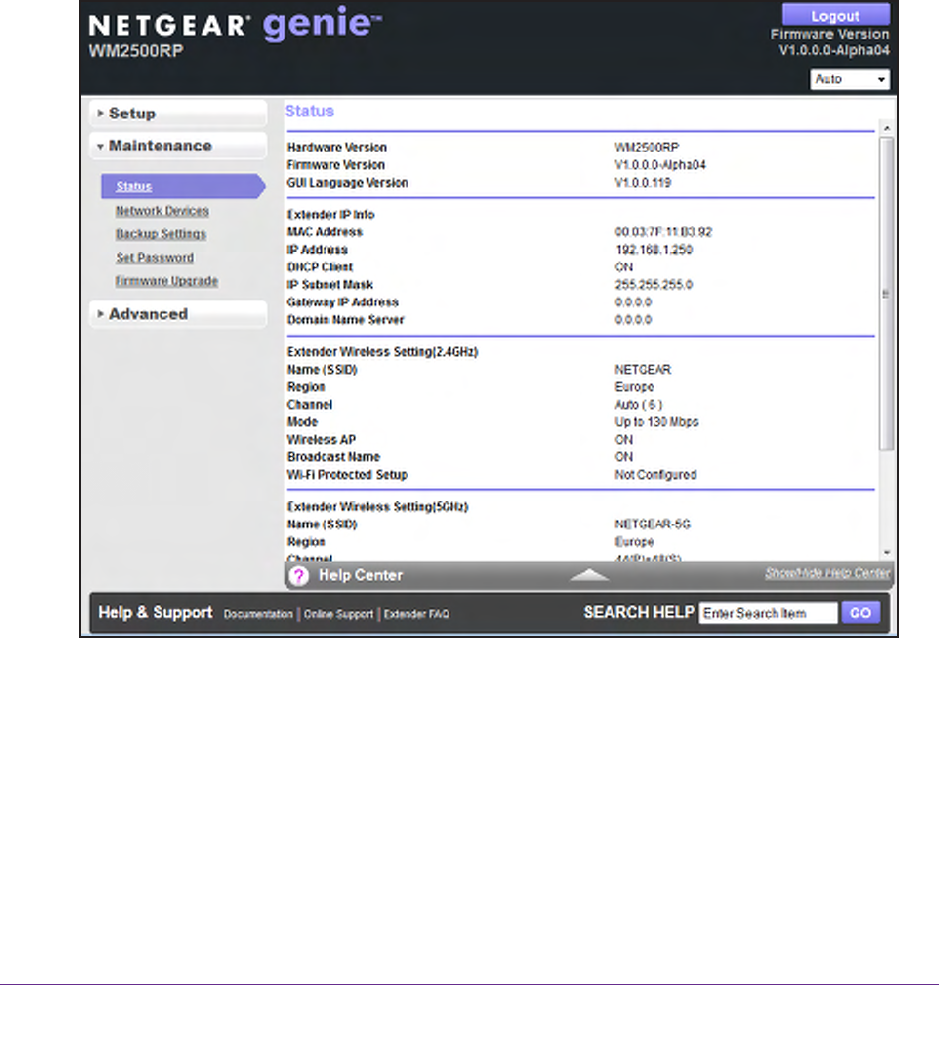
Maintenance
33
MoCA 2.0 N600 WiFi Bridge/Extender WM2500RP
WiFi Bridge/Extender Status
View information about the WiFi bridge/extender, the Internet port, and the wireless settings
(this screen is referred to as the Status screen):
To view WiFi bridge/extender status and statistics information and change the polling
frequency:
1. Log in to the WiFi bridge/extender.
For more information, see Use NETGEAR genie after Installation on page 16.
2. Click Maintenance > Status.
The following information displays:
•Hardware Version. The WiFi bridge/extender model.
•Firmware Version. The version of the WiFi bridge/extender firmware. It changes if
you upgrade the WiFi bridge/extender firmware.
•GUI Language Version. The localized language of the WiFi bridge/extender user
interface.
•Extender IP Info:

Maintenance
34
MoCA 2.0 N600 WiFi Bridge/Extender WM2500RP
- MAC Address. The Media Access Control (MAC) address for the Internet port.
This address is the unique physical address that the Internet (WAN) port of the
WiFi bridge/extender uses.
- IP Address. The IP address that the Internet (WAN) port of the WiFi
bridge/extender uses. If no address is shown or the address is 0.0.0.0, the WiFi
bridge/extender is not connected to the Internet.
- DHCP Client. Identifies whether the WiFi bridge/extender’s built-in DHCP server
is active for the LAN-attached devices.
- IP Subnet Mask. The IP subnet mask that the Internet port of the WiFi
bridge/extender uses.
- Domain Name Server. The Domain Name Server address that the WiFi
bridge/extender uses. A Domain Name Server translates human-language URLs
such as www.netgear.com into IP addresses.
•Extender Wireless Setting (2.4 GHz) and Extender Wireless Setting (5 GHz).
The following 2.4 GHz and 5 GHz WiFi band settings are displayed separately:
- Name (SSID). The wireless network name (SSID) that the WiFi bridge/extender
uses.
- Region. The geographic region where the WiFi bridge/extender is used. It might
be illegal to use the wireless features of the WiFi bridge/extender in some parts of
the world.
- Channel. Identifies the operating channel of the wireless port. The default
channel is Auto. When Auto is selected, the WiFi bridge/extender finds the best
operating channel available.
- Mode. Indicates the wireless communication mode: Up to 54 Mbps, Up to 150
Mbps (the default), or Up to 300 Mbps.
- Wireless AP. Indicates whether the radio of the WiFi bridge/extender is enabled.
If the radio is not enabled, the WiFi LED on the front panel is off.
- Broadcast Name. Indicates whether the WiFi bridge/extender is broadcasting its
SSID.
- Wi-Fi Protected Setup. Indicates whether Wi-Fi Protected Setup is configured for
this network.
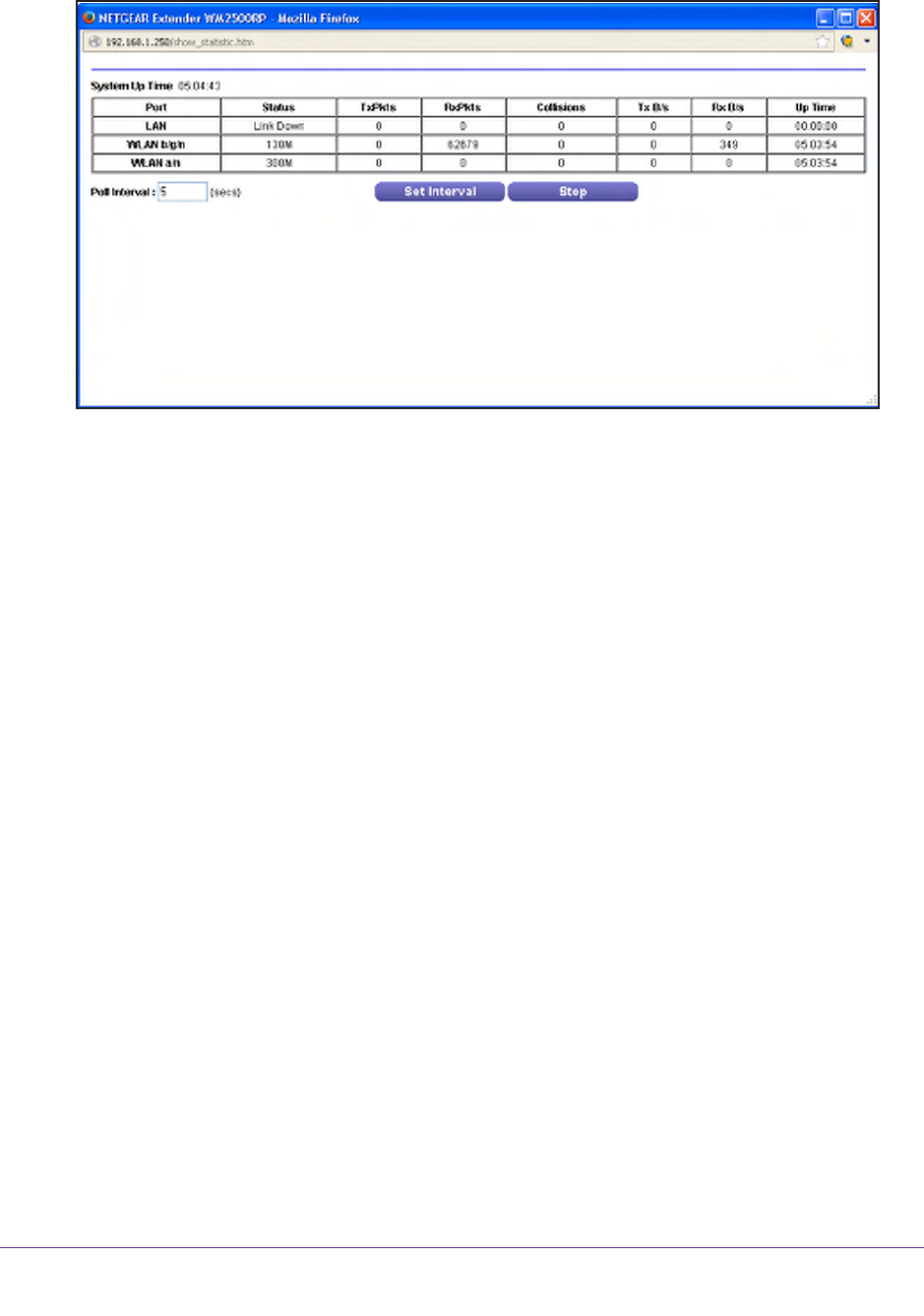
Maintenance
35
MoCA 2.0 N600 WiFi Bridge/Extender WM2500RP
3. To display traffic statistics, click the Show Statistics button.
The following information displays:
•System Up Time. The time elapsed since the WiFi bridge/extender was last
restarted.
•Port. The statistics for the WAN (Internet) port, the four LAN (Ethernet) ports
combined, and the wireless LAN (WLAN) port.
•Status. The link status of the port.
•TxPkts. The number of packets transmitted on this port since reset or manual clear.
•RxPkts. The number of packets received on this port since reset or manual clear.
•Collisions. The number of collisions on this port since reset or manual clear.
•Tx B/s. The current transmission (outbound) bandwidth that is used on the port.
•Rx B/s. The current reception (inbound) bandwidth that is used on the port.
•Up Time. The time elapsed since this port acquired the link.
•Poll Interval. The interval at which the statistics are updated on this screen.
4. To change the polling frequency, enter a time in seconds in the Poll Interval field, and click
the Set Interval button.
5. To stop the polling entirely, click the Stop button.
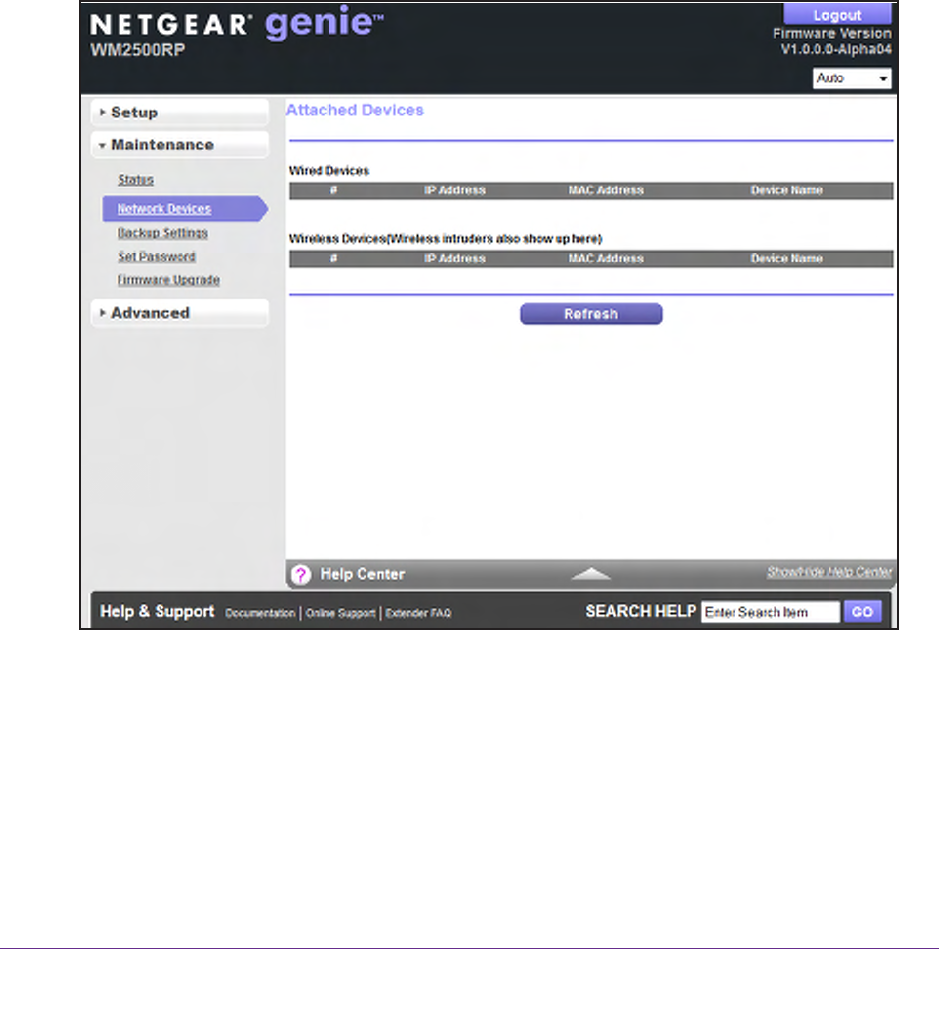
Maintenance
36
MoCA 2.0 N600 WiFi Bridge/Extender WM2500RP
View Network Devices
You can view a list of all the computers and devices that are currently connected to your
wired and wireless networks. Both authorized and unauthorized users (intruders) display.
Wired devices are connected to the WiFi bridge/extender through Ethernet cables. WiFi
devices have joined the WiFi bridge/extender wirelessly.
To view the devices that are connected to your networks:
1. Log in to the WiFi bridge/extender.
For more information, see Use NETGEAR genie after Installation on page 16.
2. Select Maintenance > Network Devices.
The Wired Devices and Wireless Devices tables show the following information:
•# (number). The order in which the device joined the network.
•IP Address. The IP address that the WiFi bridge/extender assigned to this device
when it joined the network. This number can change when a device is disconnected
and rejoins the network.
•MAC Address. The unique MAC address for each device does not change. The MAC
address is typically shown on the product label.
•Device Name. If the device name is known, it is shown here.
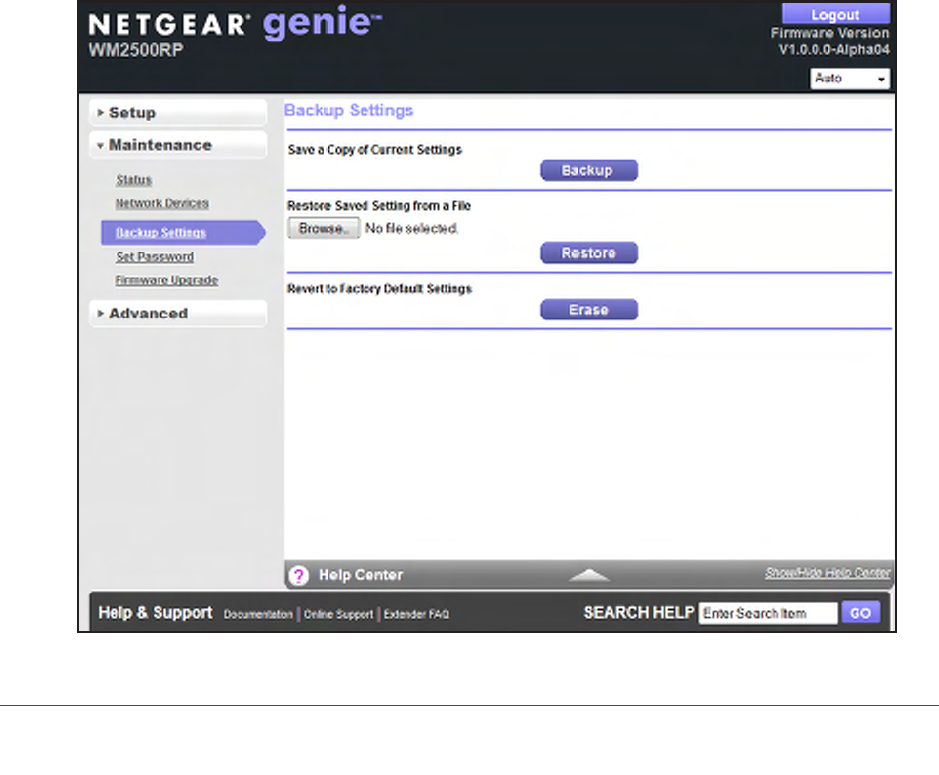
Maintenance
37
MoCA 2.0 N600 WiFi Bridge/Extender WM2500RP
3. To make sure that all of the attached devices are authorized, examine the devices carefully.
To increase security, enable access control. For more information, see Set Up a Wireless
Card Access List on page 47.
4. (Optional) Click the Refresh button.
The information that is displayed is updated.
Manage the Configuration File
The configuration settings of the WiFi bridge/extender are stored within the WiFi
bridge/extender in a configuration file. You can back up (save) this file to your computer,
restore it, or reset it to the factory default settings.
Back Up Settings
To back up the WiFi bridge/extender’s configuration settings:
1. Log in to the WiFi bridge/extender.
For more information, see Use NETGEAR genie after Installation on page 16.
2. Select Maintenance > Backup Settings.

Maintenance
38
MoCA 2.0 N600 WiFi Bridge/Extender WM2500RP
3. To save a copy of the current settings, click the Back Up button.
4. Choose a location that is on a computer on your network.
5. Click the OK button.
A copy of the current settings is saved.
Restore Configuration Settings
To restore configuration settings that you backed up:
1. Log in to the WiFi bridge/extender.
For more information, see Use NETGEAR genie after Installation on page 16.
2. Select Maintenance > Backup Settings.
The Backup Settings screen displays.
3. To find the .cfg file, click the Browse button.
4. Select the file and then click the Restore button.
The file is uploaded to the router.
The WiFi bridge/extender reboots.
WARNING:
Do not interrupt the reboot process.
Erase
Under some circumstances (for example, if you move the WiFi bridge/extender to a different
network), you might want to erase the current configuration and restore the factory default
settings. See Factory Settings on page 57.
To erase the configuration and restore the factory default settings:
1. Log in to the WiFi bridge/extender.
For more information, see Use NETGEAR genie after Installation on page 16.
2. Select Maintenance > Backup Settings.
The Backup Settings screen displays.
3. Click the Erase button.
4. To confirm the action click the Yes button.
The WiFi bridge/extender reboots.
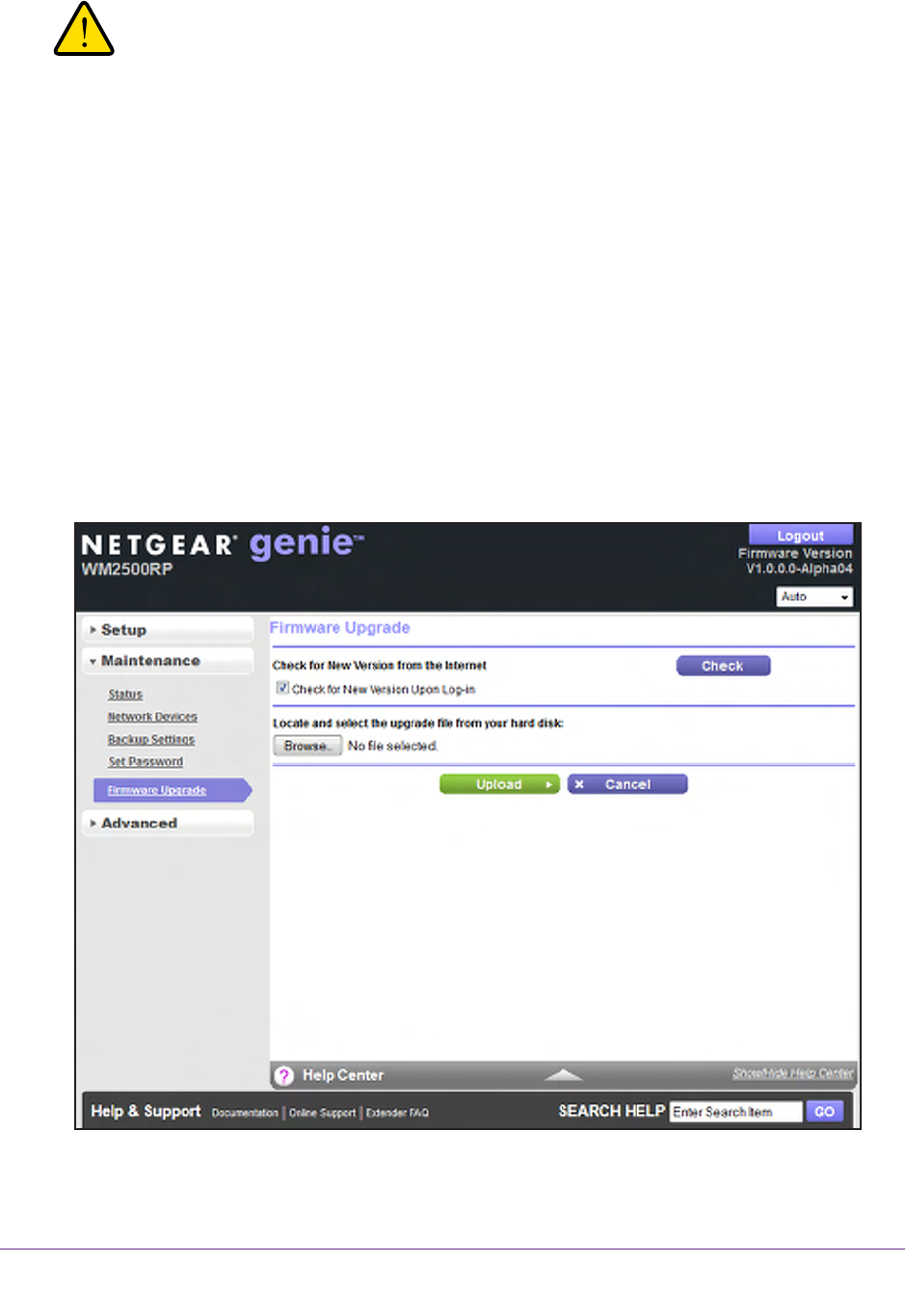
Maintenance
39
MoCA 2.0 N600 WiFi Bridge/Extender WM2500RP
WARNING:
Do not interrupt the reboot process.
Erasing sets the user name to admin, the password to password, and the LAN IP address to
192.168.1.250, and enables the WiFi bridge/extender’s DHCP server.
Upgrade the WiFi Bridge/Extender Firmware
The WiFi bridge/extender’s firmware (software) is stored in flash memory. If the WiFi
bridge/extender has detected that new firmware is available, you might see a message at the
top of the genie screens. If new firmware is available, you can also use the Check button on
the Firmware Upgrade screen to check for it manually.
To check for new firmware and update your WiFi bridge/extender:
1. Log in to the WiFi bridge/extender.
For more information, see Use NETGEAR genie after Installation on page 16.
2. Select Maintenance > Firmware Upgrade.
3. Click the Check button.
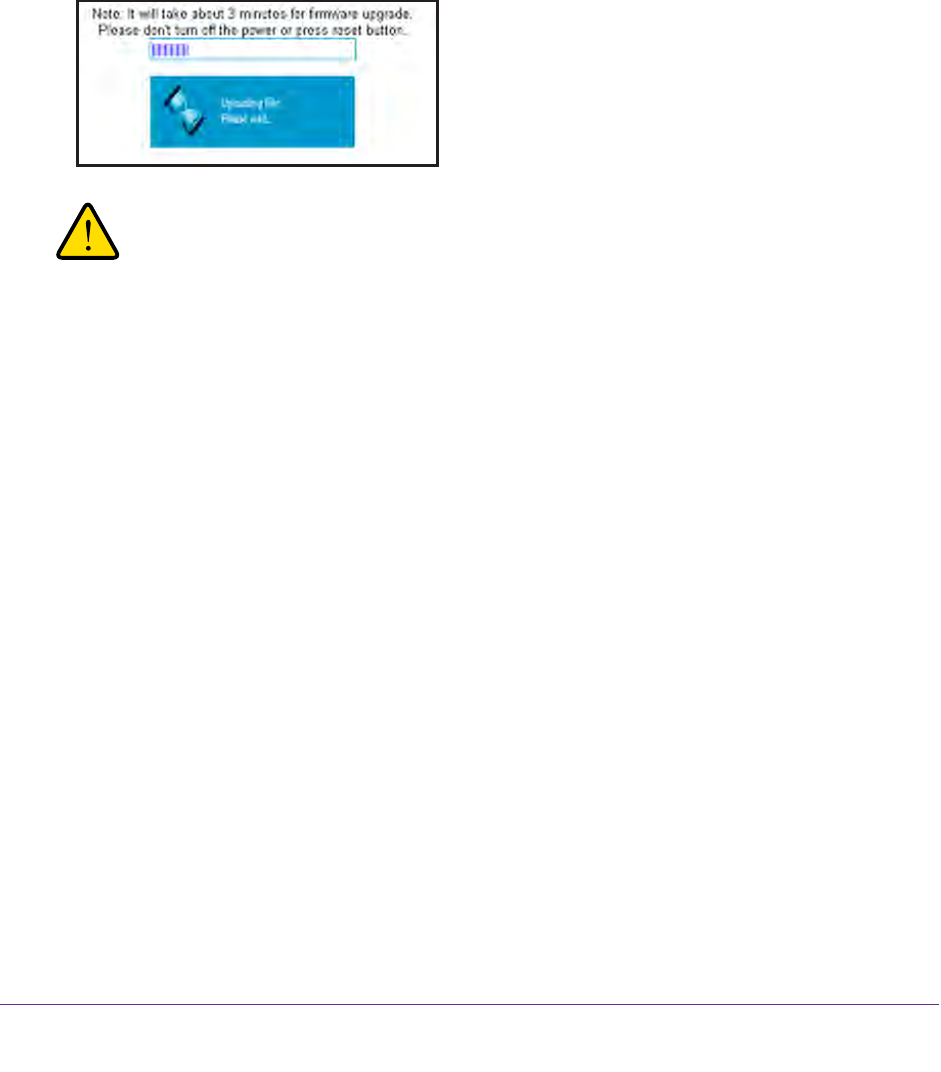
Maintenance
40
MoCA 2.0 N600 WiFi Bridge/Extender WM2500RP
If new firmware is available, the WiFi bridge/extender detects it and displays the Firmware
Upgrade Assistant screen.
4. To update the WiFi bridge/extender to the new firmware, click the Yes button.
5. (Optional) If you have manually downloaded new firmware from the NETGEAR support
website, do the following:
a. Click the Browse button, navigate to the firmware file (the file ends in .img), and
select the firmware file.
b. Click the Upload button.
A progress bar shows the progress of the firmware upload process:
WARNING:
When uploading firmware to the WiFi bridge/extender, do not
interrupt the web browser by closing the window, clicking a link,
or loading a new page. If the browser is interrupted, the firmware
might be corrupted.
When the upload is complete, your WiFi bridge/extender restarts. The upload process
can take up to three minutes, and the upgrade process typically takes about one minute.
To determine whether you need to reconfigure the WiFi bridge/extender after upgrading,
read the new firmware release notes.

41
5
5. Advanced Settings
Enhance your wireless performance
This chapter describes the advanced wireless features of your WiFi bridge/extender. The
information is for users with a solid understanding of networking concepts.
This chapter includes the following sections:
•Advanced Wireless Settings
•Set Up a Wireless Schedule
•Set Up the WPS Settings
•Set Up a Wireless Card Access List
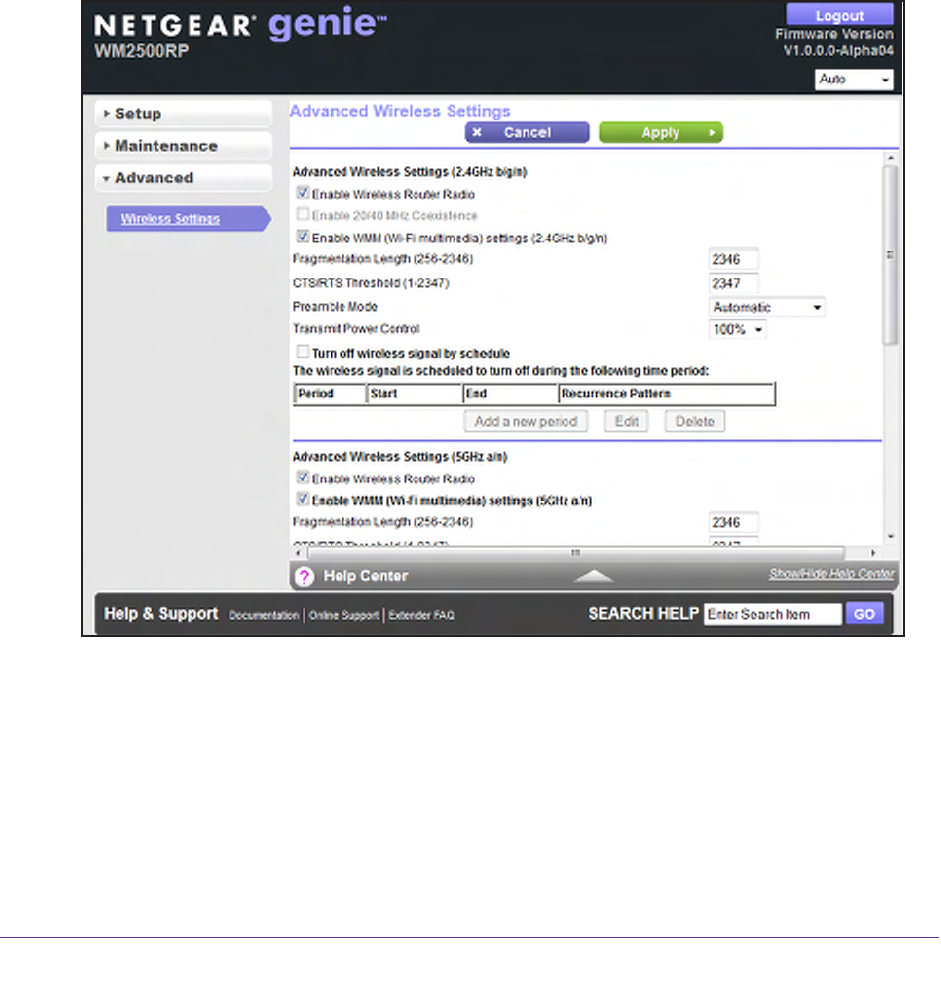
Advanced Settings
42
MoCA 2.0 N600 WiFi Bridge/Extender WM2500RP
Advanced Wireless Settings
You can configure advanced settings for your wireless network. You can also set up a
schedule to turn off your wireless network, configure the WPS settings, and set up an access
list for wireless clients.
Use caution when changing these settings.
To change advanced settings for your wireless network:
1. Log in to the WiFi bridge/extender.
For more information, see Use NETGEAR genie after Installation on page 16.
2. Select Advanced > Wireless Settings.
You configure the 2.4 GHz and 5 GHz WiFi bands separately.
3. To completely turn off the wireless radio of the WiFi bridge/extender, clear the Enable
Wireless Router Radio check box.
When the wireless radio is disabled, you can still use the WiFi bridge/extender by
connecting computers to the WiFi bridge/extender with an Ethernet cable. By default, the
wireless radio is enabled.

Advanced Settings
43
MoCA 2.0 N600 WiFi Bridge/Extender WM2500RP
4. To increase the wireless speed to the maximum supported speed, clear the Enable
20/40 MHz Coexistence check box.
This setting applies only to the 2.4 GHz band.
By default, 20/40 MHz coexistence is enabled to prevent interference between wireless
networks in your environment at the expense of the wireless speed. If no other wireless
networks exist in your environment, you can clear the Enable 20/40 MHz Coexistence
check box.
5. To enable WiFi multimedia, select the Enable WMM (Wi-Fi multimedia) settings check
box.
IMPORTANT:
The Fragmentation Length, CTS/RTS Threshold, and Preamble
Mode options are reserved for wireless testing and advanced
configuration only. Do not change these settings.
6. From the Transmit Power Control list, select the transmit power that you want.
7. Set up a wireless schedule.
For more information, see Set Up a Wireless Schedule on page 43.
8. Set up the WPS settings.
For more information, see Set Up the WPS Settings on page 45.
9. Set up a wireless card control list.
For more information, see Set Up a Wireless Card Access List on page 47.
10. Click the Apply button.
Set Up a Wireless Schedule
You can use this feature to turn off the wireless signal from your WiFi bridge/extender at
times when you do not need a wireless connection. For example, you could turn it off for the
weekend if you leave town.
To configure and enable the wireless schedule:
1. Log in to the WiFi bridge/extender.
For more information, see Use NETGEAR genie after Installation on page 16.
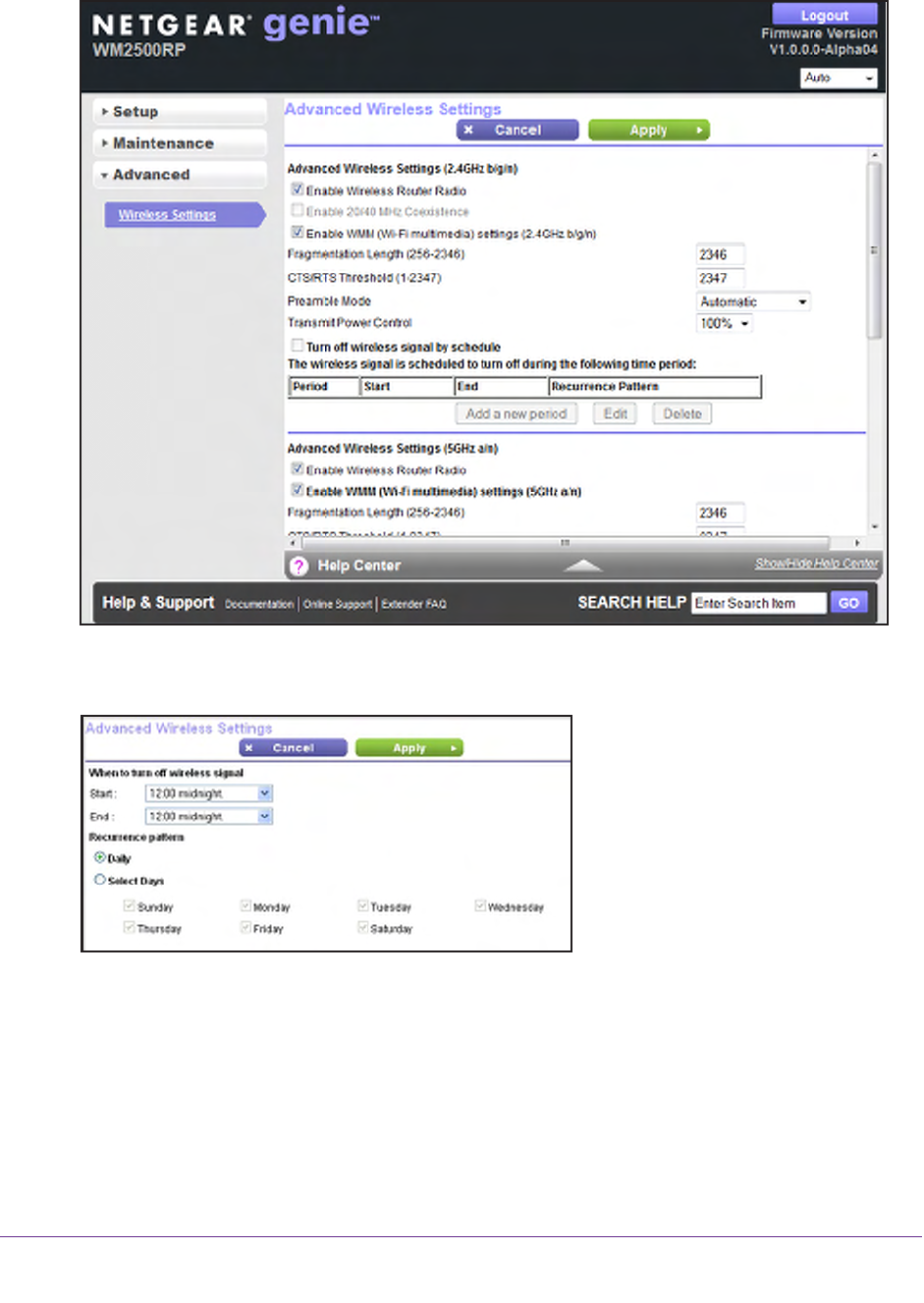
Advanced Settings
44
MoCA 2.0 N600 WiFi Bridge/Extender WM2500RP
2. Select Advanced > Wireless Settings.
3. Click the Add a new period button.
The screen adjusts:
4. Use the lists, radio buttons, and check boxes to set up a period during which you want to
turn off the wireless signal.
5. Click the Apply button.
The Advanced Wireless Settings screen displays.
6. To activate the schedule, select the Turn off wireless signal by schedule check box.
7. Click the Apply button.

Advanced Settings
45
MoCA 2.0 N600 WiFi Bridge/Extender WM2500RP
Set Up the WPS Settings
You can control how WPS functions on the WiFi bridge/extender. Use caution when changing
the WPS settings.
Note: For information about how to use WPS to add wireless devices and
other equipment to your wireless network, see Wi-Fi Protected
Setup Method on page 20.
You cannot set up the WPS settings when the security is WEP. Make sure that the security
mode is WPA-PSK, WPA2-PSK, or WPA-PSK + WPA2-PSK mixed mode. For information
about configuring the security mode, see Basic Wireless Settings on page 22.
You can do the following with the WiFi bridge/extender’s PIN:
•Disable the PIN entirely.
•Change the number of times that a PIN connection is allowed to fail before the PIN is
automatically disabled. By default, the PIN is automatically disabled after three failed
connection attempts. If the PIN is automatically disabled, it remains so until you restart
the WiFi bridge/extender. While the PIN is disabled, the WPS LED blinks slowly.
•Turn off automatic disabling of the PIN.
To change the WPS settings for your wireless network:
1. Log in to the WiFi bridge/extender.
For more information, see Use NETGEAR genie after Installation on page 16.
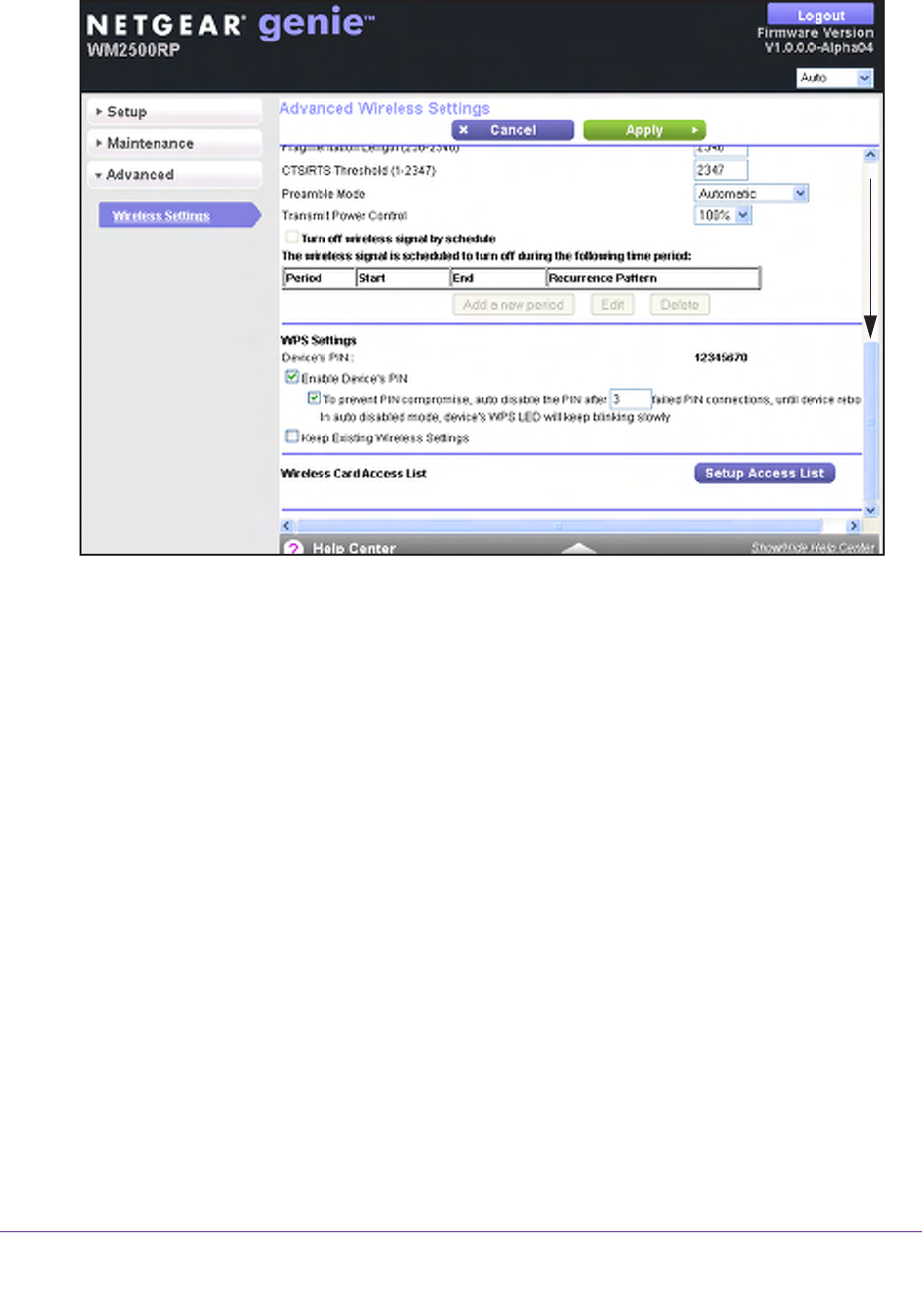
Advanced Settings
46
MoCA 2.0 N600 WiFi Bridge/Extender WM2500RP
2. Select Advanced > Wireless Settings.
Scroll
down
The WiFi bridge/extender’s PIN is shown for information only. You cannot change it.
3. To disable the WiFi bridge/extender’s PIN entirely, clear the Enable Router’s PIN check
box.
By default, the PIN is enabled, but there might be situations in which you want to disable
the PIN.
4. To change the number of times that a PIN connection can fail, below the Enable Router's
PIN check box, type a number in the field.
You can change this setting only when the PIN is enabled. By default, the number is 3.
5. To turn off automatic disabling of the PIN, clear the check box below the Enable Router’s
PIN check box.
You can change this setting only when the PIN is enabled. By default, automatic disabling
of the PIN is turned on.
6. Clear the Keep Existing Wireless Settings check box.
This check box is selected by default. However, when the check box is selected, some
applications such as Network Explorer in Windows Vista might not detect the WiFi
bridge/extender.
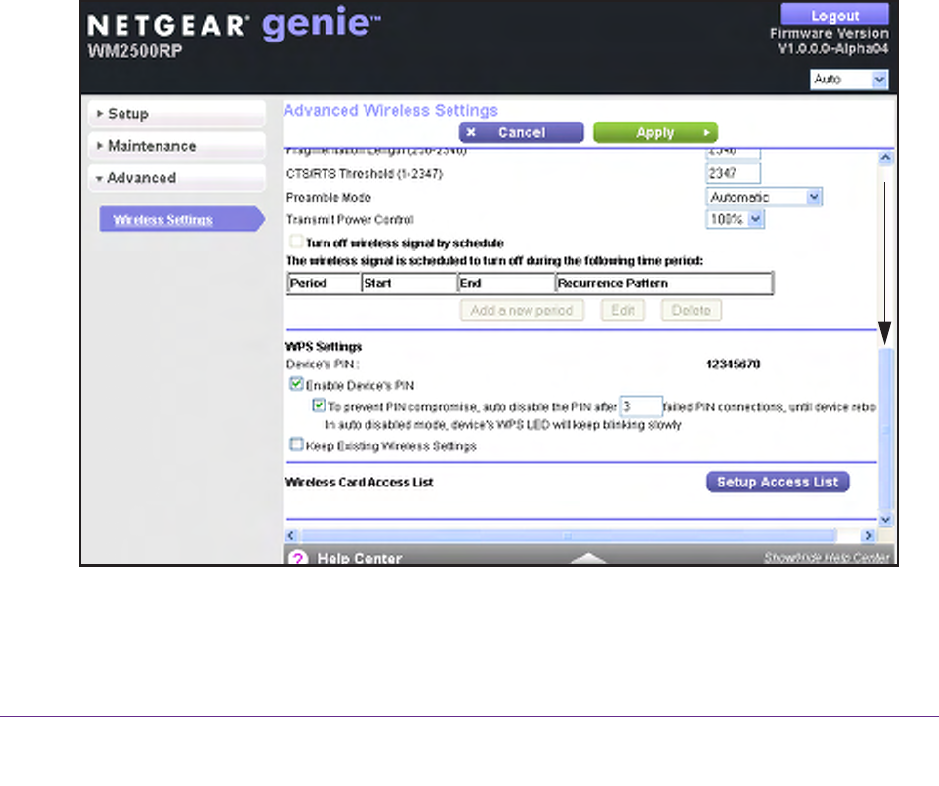
Advanced Settings
47
MoCA 2.0 N600 WiFi Bridge/Extender WM2500RP
CAUTION: When you clear this check box and you add a new wireless client
through WPS, the WiFi bridge/extender’s wireless settings change to
an automatically generated SSID and passphrase. (The passphrase
is also referred to as the wireless network password or network key).
7. Click the Apply button.
Set Up a Wireless Card Access List
By default, any wireless device that is configured with the correct SSID can access your
wireless network. For increased security, you can restrict access to the wireless network to
allow only specific devices based on their MAC addresses.
For information about how to view the devices that are attached to your wireless network, see
View Network Devices on page 36.
To set up access control:
1. Log in to the WiFi bridge/extender.
For more information, see Use NETGEAR genie after Installation on page 16.
2. Select Advanced > Wireless Settings.
Scroll
down
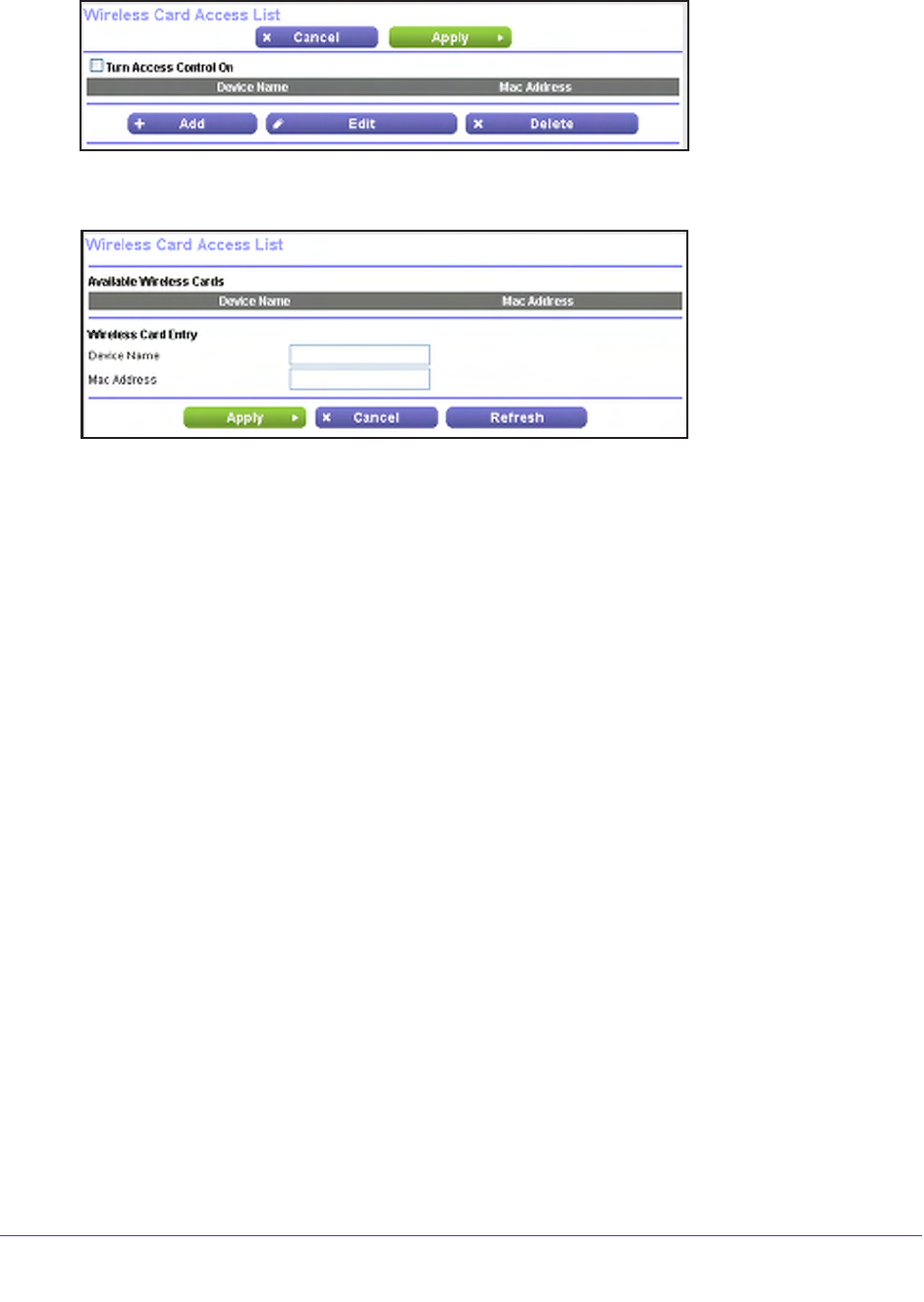
Advanced Settings
48
MoCA 2.0 N600 WiFi Bridge/Extender WM2500RP
3. Click the Setup Access List button.
4. Select the Turn on Access Control check box.
5. Click the Add button.
6. For the WiFi device that you want to allow to access the network, enter a device name and
its wireless MAC address.
7. Click the Apply button.
The device appears on the wireless card access list.
8. Repeat Step 5 through Step 7 for each WiFi device that you want to add.
9. Click the Apply button.
You settings are saved.

49
6
6. Troubleshooting
Find and fix problems
This chapter provides information to help you diagnose and solve problems you might have with
your WiFi bridge/extender.
The chapter contains the following sections:
•Quick Tips
•Troubleshoot with the LEDs
•Cannot Log In to the WiFi Bridge/Extender
•Cannot Access the Internet
•Changes Not Saved
•Wireless Connectivity

Troubleshooting
50
MoCA 2.0 N600 WiFi Bridge/Extender WM2500RP
Quick Tips
This section describes tips for troubleshooting some common problems.
Sequence to Restart Your Network
Make sure to restart your network in this sequence:
1. Unplug and turn off the cable modem.
2. Turn off the WiFi bridge/extender and computers.
3. Plug in the cable modem and turn it on. Wait two minutes.
4. Turn on the WiFi bridge/extender and wait two minutes.
5. Turn on the computers.
Check Ethernet Cable Connections
Make sure that the Ethernet cables are securely plugged in.
The Internet LED on the WiFi bridge/extender is lit when the Ethernet cable connecting the
WiFi bridge/extender and the modem is plugged in securely and the modem and WiFi
bridge/extender are turned on.
For each powered-on computer connected to the WiFi bridge/extender by an Ethernet cable,
the corresponding numbered WiFi bridge/extender LAN port LED is lit.
Wireless Settings
Make sure that the wireless settings in the computer and WiFi bridge/extender match exactly.
For a wirelessly connected computer, the wireless network name (SSID) and wireless
security settings of the WiFi bridge/extender and wireless computer must match exactly.
If you set up an access list in the Advanced Wireless Settings screen, you must add each
wireless computer’s MAC address to the WiFi bridge/extender’s access list.
Network Settings
Make sure that the network settings of the computer are correct/
Wired and wirelessly connected computers must have network IP addresses on the same
network as the WiFi bridge/extender. The simplest way to meet this requirement is to
configure each computer to obtain an IP address automatically using DHCP.
Some cable modem service providers require you to use the MAC address of the computer
initially registered on the account. You can view the MAC address in the Attached Devices
screen (see View Network Devices on page 36).

Troubleshooting
51
MoCA 2.0 N600 WiFi Bridge/Extender WM2500RP
Troubleshoot with the LEDs
After you turn on power to the WiFi bridge/extender, the following sequence of events occurs:
1. When power is first applied, verify that the Power LED is on.
2. Verify that the Power LED turns amber within a few seconds, indicating that the self-test is
running.
3. After approximately 30 seconds, verify the following:
•The Power LED is solid green.
•The Internet LED is lit.
•A numbered LAN Ethernet port LED is lit for any local port that is connected to a
computer. This condition indicates that a link has been established to the connected
device.
You can use the LEDs on the front panel of the WiFi bridge/extender for troubleshooting.
Table 3. Troubleshooting with LEDs
No LEDs are lit on
the WiFi
bridge/extender.
The WiFi bridge/extender has no power. Make sure of the following:
• The power adapter is correctly connected to the WiFi bridge/extender.
• The power adapter is correctly connected to a functioning power outlet. If it is
connected to a power strip, make sure that the power strip is turned on.
• You are using the correct power adapter.
MoCA LED does not
light.
You have a hardware connection problem. Do the following:
• Make sure that the cable connector is securely plugged in at the WiFi
bridge/extender.
• Turn the power to the WiFi bridge/extender off and on.
• Make sure that MoCA is enabled on your existing cable router.
• If your existing MoCA cable router uses an encryption key, make sure that the
encryption key is enabled in the WiFi bridge/extender and that the key matched the
encryption key used by the existing MoCA cable router. For more information, see
Coax Settings on page 30.
Ethernet LED does
not light even though
a device is attached.
You have a hardware connection problem. Do the following:
• Make sure that the cable connector is securely plugged in to the WiFi
bridge/extender and the computer.
• If you are not using the cable included with the WiFi bridge/extender, make sure that
the Ethernet cable is a straight-through patch cable.

Troubleshooting
52
MoCA 2.0 N600 WiFi Bridge/Extender WM2500RP
Power LED Is Off or Blinking
Make sure that the power cord is securely connected to your WiFi bridge/extender and that
the power adapter is securely connected to a functioning power outlet.
Make sure that you are using the power adapter that NETGEAR supplied for this product.
If the Power LED blinks slowly and continuously, the WiFi bridge/extender firmware is
corrupted. This can happen if a firmware upgrade is interrupted, or if the WiFi bridge/extender
detects a problem with the firmware. If the error persists, you have a hardware problem.
Power LED Stays Amber
When the WiFi bridge/extender is turned on, the Power LED turns amber for about 20
seconds and then turns green. If the LED does not turn green, the WiFi bridge/extender has a
problem.
When the Power LED is still amber one minute after you turn on power to the WiFi
bridge/extender, do the following:
1. Turn the power off and back on to see if the WiFi bridge/extender recovers.
2. To return the WiFi bridge/extender to its factory settings, press and hold the Reset button.
For more information, see Factory Settings on page 57.
If the error persists, you might have a hardware problem.
All LEDs Remain Lit After Startup
When the WiFi bridge/extender is turned on, the LEDs light for about 10 seconds and then
turn off. If all the LEDs stay lit, a fault exists within the WiFi bridge/extender.
You cannot connect
to the Internet.
It can take a couple of minutes to establish a connection the first time you power on your
WiFi bridge/extender. Always leave your WiFi bridge/extender plugged in to AC power
and connected to the cable system. Do the following:
• Check your cable connections. Make sure that connectors are finger tight.
• Make sure that you have powered up in the following sequence:
1. Turn on your WiFi bridge/extender first, and wait until the LEDs
stop blinking.
2. If your computer is connected to the WiFi bridge/extender, turn
on the computer.
• If you have a home network, check the TCP/IP configuration.
- For Windows computers, make sure that the network properties are set to obtain
an IP address automatically.
- For Macintosh computers, make sure that the TCP/IP (or Network) control panel is
set to Using DHCP Server.
Table 3. Troubleshooting with LEDs (continued)

Troubleshooting
53
MoCA 2.0 N600 WiFi Bridge/Extender WM2500RP
If all LEDs are still lit one minute after power-up, do the following:
•Turn the power off and back on to see if the WiFi bridge/extender recovers.
•To return the WiFi bridge/extender to its factory settings, press and hold the Reset button.
For more information, see Factory Settings on page 57.
If the error persists, you might have a hardware problem.
Internet or LAN Port LEDs Are Off
If one of the LAN port LEDs or the Internet LED does not light when the Ethernet connection
is made, check the following:
•Make sure that the Ethernet cable connections are secure at the WiFi bridge/extender
and at the modem or computer.
•Make sure that power is turned on to the connected cable MoCA modem or computer.
•Be sure that you are using the correct cable.
When you connect the WiFi bridge/extender’s Internet port to a cable MoCA modem, use
the cable that was supplied with the cable modem.
WiFi LEDs are Off
If the WiFi LEDs stay off, check to see if the WiFi On/Off button on the WiFi bridge/extender
has been pressed. This button turns the wireless radio in the WiFi bridge/extender on and off.
The WiFi LEDs are lit when the wireless radio is turned on.
WPS Button Blinks Amber
If, after you use the Push 'N' Connect (WPS) function, the WPS LED blinks green rapidly,
check the following:
•Make sure that you have used the WPS button on the front of the WiFi bridge/extender
and not the WPS Wizard on the Add WPS Client screen.
•Check that PIN verification succeeded for the wireless device that you are adding to the
wireless network.
•Make sure that you have not pressed the WPS button on the front of the WiFi
bridge/extender after disabling the WPS feature (you logged in to the WiFi
bridge/extender and disabled this feature previously).
•Check to see if the WiFi bridge/extender is stuck in the AP setup locked state (if you are
using the wireless repeater function). To resolve this situation, either restart the WiFi
bridge/extender, or do the following:
1. Select Advanced > Wireless Settings.
The Advanced Wireless Settings screen displays.
1. Select the Enable Router's PIN check box.

Troubleshooting
54
MoCA 2.0 N600 WiFi Bridge/Extender WM2500RP
2. Click the Apply button.
Cannot Log In to the WiFi Bridge/Extender
If you are unable to log in to the WiFi bridge/extender from a computer on your local network,
check the following:
•If you are using an Ethernet-connected computer, check the Ethernet connection
between the computer and the WiFi bridge/extender as described in Check Ethernet
Cable Connections on page 50.
•Make sure that your computer’s IP address is on the same subnet as the WiFi
bridge/extender. If you are using the recommended addressing scheme, your computer’s
address is in the range of 192.168.1.2 to 192.168.1.254.
•If your computer’s IP address is shown as 169.254.x.x, recent versions of Windows and
Mac OS generate and assign an IP address if the computer cannot reach a DHCP server.
These autogenerated addresses are in the range of 169.254.x.x. If your IP address is in
this range, check the connection from the computer to the WiFi bridge/extender, and
reboot your computer.
•If your WiFi bridge/extender’s IP address was changed and you do not know the current
IP address, clear the WiFi bridge/extender’s configuration to factory defaults. This sets
the WiFi bridge/extender’s IP address to 192.168.1.250. This procedure is explained in
Factory Settings on page 57.
•Make sure that your browser has Java, JavaScript, or ActiveX enabled. If you are using
Internet Explorer, click the Refresh button to be sure that the Java applet is loaded.
•Try quitting the browser and launching it again.
•Make sure that you are using the correct login information. The factory default login name
is admin and the password is password. Make sure that Caps Lock is off when you enter
this information.
•If you are attempting to set up your NETGEAR WiFi bridge/extender as an additional
router behind an existing router in your network, consider replacing the existing router
with the NETGEAR WiFi bridge/extender.
•If you are attempting to set up your NETGEAR WiFi bridge/extender as a replacement for
an ADSL gateway in your network, the WiFi bridge/extender cannot perform many
gateway services. For example, the WiFi bridge/extender cannot convert ADSL or cable
data into Ethernet networking information.
Cannot Access the Internet
If you can access your WiFi bridge/extender but you are unable to access the Internet, first
determine whether the WiFi bridge/extender MoCA LED is green or amber. If the MoCA LED
is off, make sure that there is another WiFi bridge/extender or MoCA device connected to the
coaxial cable network. Then make sure that one WiFi bridge/extender or MoCA device is
connected to your router or cable modem.

Troubleshooting
55
MoCA 2.0 N600 WiFi Bridge/Extender WM2500RP
Changes Not Saved
If the WiFi bridge/extender does not save the changes you make through the NETGEAR
genie screens, check the following:
•When you enter configuration settings on a screen, always click the Apply button before
you move to another screen or tab, or your changes are lost.
•Click the Refresh or Reload button in the web browser. The changes might have
occurred, but the old settings might be in the web browser’s cache.
Wireless Connectivity
If you are having trouble connecting wirelessly to the WiFi bridge/extender, try to isolate the
problem by checking the following:
•Does the wireless device or computer that you are using find your wireless network?
If not, check the WiFi LED on the front of the WiFi bridge/extender. It should be lit. If it is
not, you can press the WiFI On/Off button on the front of the WiFi bridge/extender to turn
the WiFi bridge/extender’s wireless radio back on.
If you disabled the WiFi bridge/extender’s SSID broadcast, your wireless network is
hidden and does not display in your wireless client’s scanning list. By default, SSID
broadcast is enabled.
•Does your wireless device support the security that you are using for your wireless
network (WEP, WPA, or WPA2)?
•If you want to view the wireless settings, select Setup > Wireless Settings. For more
information, see Basic Wireless Settings on page 22.
If your wireless device finds your network, but the signal strength is weak, check these
conditions:
•Is your WiFi bridge/extender too far from your computer, or too close? Place your
computer near the WiFi bridge/extender, but at least 6 feet (2 meters) away, and see
whether the signal strength improves.
•Is your wireless signal blocked by objects between the WiFi bridge/extender and your
computer?

Supplemental Information
57
MoCA 2.0 N600 WiFi Bridge/Extender WM2500RP
Factory Settings
You can return the WiFi bridge/extender to its factory settings. Use the end of a paper clip or
some other similar object to press and hold the Reset button on the back panel of the WiFi
bridge/extender for at least seven seconds. The WiFi bridge/extender resets, and returns to
the factory settings that are shown in the following table.
Table 4. WM2500RP WiFi bridge/extender factory default settings
Feature Default Behavior
Router login User login URL www.routerlogin.com or www.routerlogin.net
User name (case-sensitive) admin
Login password (case-sensitive) password
Local area
network (LAN)
LAN IP 192.168.1.250
Subnet mask 255.255.255.0
DHCP server Enabled
DHCP range 192.168.1.2 to 192.168.1.254
Wireless Wireless communication Enabled
SSID name
Network key (password)
Broadcast SSID Enabled
Transmission speed Auto
Country/region United States in the US; otherwise, varies by region
RF channel Auto
Operating mode Up to 300 Mbps
20/40 MHz coexistence Enabled
Data rate Best
Output power Full
Preset. For information, see the WiFi bridge/extender
label. (For a description of the WiFi bridge/extender label,
see Label on page 10.)
Note: Maximum wireless signal rate derived from IEEE
Standard 802.11 specifications. Actual throughput varies.
Network conditions and environmental factors, including
volume of network traffic, building materials and
construction, and network overhead lower actual data
throughput rate.

Supplemental Information
58
MoCA 2.0 N600 WiFi Bridge/Extender WM2500RP
Technical Specifications
Table 5. WM2500RP WiFi bridge/extender specifications
Feature Description
Data and routing protocols TCP/IP, RIP-1, RIP-2, DHCP, PPPoE, PPTP, Bigpond, Dynamic DNS, UPnP, and
SMB
Power adapter • North America: 120V, 60 Hz, input
• UK, Australia: 240V, 50 Hz, input
• Europe: 230V, 50 Hz, input
• All regions (output): 12 VDC @ 1.5A, output
Dimensions 217.74 x 147.73 x 34.92 mm (8.57 x 5.81 x 1.37 in.)
Weight 0.41 kg (0.91 lb)
Operating temperature 0° to 40°C (32º to 104ºF)
Operating humidity 90% maximum relative humidity, noncondensing
Electromagnetic Emissions FCC Part 15 Class B
VCCI Class B
EN 55 022 (CISPR 22), Class B C-Tick N10947
LAN 10BASE-T or 100BASE-Tx, RJ-45
Wireless Maximum wireless signal rate complies with the IEEE 802.11 standard. See the
entry for Transmission speed in the previous table.
Radio data rates Auto Rate Sensing
Data encoding standards IEEE 802.11n version 2.0
IEEE 802.11n, IEEE 802.11g, IEEE 802.11b 2.4 GHz
Maximum computers per
wireless network
Limited by the amount of wireless network traffic generated by each node
(typically 50–70 nodes)
WiFi operating frequency
range
2.4 GHz
• 2.412–2.462 GHz (US)
• 2.412–2.472 GHz (Japan)
• 2.412–2.472 GHz (Europe ETSI)
5 GHz
• 5.18–5.24 + 5.745–5.825 GHz (US)
• 5.18–5.24 GHz (Europe ETSI)
802.11 security WEP, WPA-PSK, WPA2-PSK, WPA-PSK + WPA2-PSK mixed mode,
WPA/WPA2 Enterprise
MoCA operating frequency
range
1125–1525 MHz

59
B
B. Notification of Compliance
NETGEAR dual band - wireless
Regulatory Compliance Information
This section includes user requirements for operating this product in accordance with National laws for usage of radio
spectrum and operation of radio devices. Failure of the end-user to comply with the applicable requirements may
result in unlawful operation and adverse action against the end-user by the applicable National regulatory authority.
This product's firmware limits operation to only the channels allowed in a particular Region or Country. Therefore, all
options described in this user's guide may not be available in your version of the product.
Europe – EU Declaration of Conformity
Products bearing the marking comply with the following EU directives:
• EMC Directive 2004/108/EC
• Low Voltage Directive 2006/95/EC
If this product has telecommunications functionality, it also complies with the requirements of the following EU
Directive:
• R&TTE Directive 1999/5/EC
Compliance with these directives implies conformity to harmonized European standards that are noted in the EU
Declaration of Conformity.
For indoor use only. Valid in all EU member states, EFTA states, and Switzerland.
This device may not be used for setting up outdoor radio links in France and in some areas the RF output power may
be limited to 10 mW EIRP in the frequency range of 2454 - 2483.5 MHz. For detailed information the end-user should
contact the national spectrum authority in France.
FCC Requirements for Operation in the United States
FCC Information to User
This product does not contain any user serviceable components and is to be used with approved antennas only.
Any product changes or modifications will invalidate all applicable regulatory certifications and approvals.
FCC Guidelines for Human Exposure
This equipment complies with FCC radiation exposure limits set forth for an uncontrolled environment. This
equipment should be installed and operated with minimum distance of 20 cm between the radiator and your body.
This device and its antenna(s) must not be co-located or operating in conjunction with any other antenna or
transmitter except in accordance with FCC multi-transmitter product procedures.
FCC Declaration of Conformity
We, NETGEAR, Inc., 350 East Plumeria Drive, San Jose, CA 95134, declare under our sole responsibility that the
MoCA 2.0 N600 WiFi Bridge/Extender WM2500RP complies with Part 15 Subpart B of FCC CFR47 Rules.
Operation is subject to the following two conditions:
• This device may not cause harmful interference, and
• This device must accept any interference received, including interference that may cause undesired operation.

Notification of Compliance
60
MoCA 2.0 N600 WiFi Bridge/Extender WM2500RP
FCC Radio Frequency Interference Warnings & Instructions
This equipment has been tested and found to comply with the limits for a Class B digital device, pursuant to Part 15
of the FCC Rules. These limits are designed to provide reasonable protection against harmful interference in a
residential installation. This equipment uses and can radiate radio frequency energy and, if not installed and used in
accordance with the instructions, may cause harmful interference to radio communications. However, there is no
guarantee that interference will not occur in a particular installation. If this equipment does cause harmful
interference to radio or television reception, which can be determined by turning the equipment off and on, the user
is encouraged to try to correct the interference by one or more of the following methods:
• Reorient or relocate the receiving antenna.
• Increase the separation between the equipment and the receiver.
• Connect the equipment into an electrical outlet on a circuit different from that which the radio receiver is
connected.
• Consult the dealer or an experienced radio/TV technician for help.
FCC Caution
• Any changes or modifications not expressly approved by the party responsible for compliance could void the
user's authority to operate this equipment.
• This device complies with Part 15 of the FCC Rules. Operation is subject to the following two conditions: (1) This
device may not cause harmful interference, and (2) this device must accept any interference received, including
interference that may cause undesired operation.
• For product available in the USA and Canada market, only channel 1~11 can be operated. Selection of other
channels is not possible.
• Pour les produits disponibles aux États-Unis / Canada du marché, seul le canal 1 à 11 peuvent être exploités.
Sélection d'autres canaux n'est pas possible.
• This device and its antenna(s) must not be co-located or operating in conjunction with any other antenna or
transmitter except in accordance with FCC multi-transmitter product procedures.
• Cet appareil et son antenne (s) ne doit pas être co-localisés ou fonctionnement en association avec une autre
antenne ou transmetteur.
• For operation within a 5.15 ~ 5.25 GHz/5.47 ~ 5.725 GHz frequency range, it is restricted to an indoor
environment. The band from 5600-5650 MHz will be disabled by the software during the manufacturing and
cannot be changed by the end user. This device meets all the other requirements specified in Part 15E, Section
15.407 of the FCC Rules.
• Devices will not permit operations on channels 120-132 for 11a and 11n/a which overlap the 5600 - 5650 MHz
band.
Canadian Department of Communications Radio Interference Regulations
This digital apparatus (MoCA 2.0 N600 WiFi Bridge/Extender WM2500RP) does not exceed the Class B limits for
radio-noise emissions from digital apparatus as set out in the Radio Interference Regulations of the Canadian
Department of Communications.
CAN ICES-3 (B)/NMB-3(B)
Industry Canada
This device complies with RSS-210 of the Industry Canada Rules. Operation is subject to the following two conditions:
(1) This device may not cause harmful interference, and (2) this device must accept any interference received,
including interference that may cause undesired operation.
Ce dispositif est conforme à la norme CNR-210 d'Industrie Canada applicable aux appareils radio exempts de licence.
Son fonctionnement est sujet aux deux conditions suivantes: (1) le dispositif ne doit pas produire de brouillage
préjudiciable, et (2) ce dispositif doit accepter tout brouillage reçu, y compris un brouillage susceptible de provoquer un
fonctionnement indésirable.
The device could automatically discontinue transmission in case of absence of information to transmit, or operational
failure. Note that this is not intended to prohibit transmission of control or signaling information or the use of repetitive
codes where required by the technology.
Le dispositif pourrait automatiquement cesser d'émettre en cas d'absence d'informations à transmettre, ou une
défaillance opérationnelle. Notez que ce n'est pas l'intention d'interdire la transmission des informations de contrôle ou
de signalisation ou l'utilisation de codes répétitifs lorsque requis par la technologie.
Operations in the 5.15-5.25GHz band are restricted to indoor usage only.

Notification of Compliance
61
MoCA 2.0 N600 WiFi Bridge/Extender WM2500RP
Dynamic Frequency Selection (DFS) for devices operating in the bands 5250-5350 MHz,5470-5600 MHz and
5650-5725 MHz.
Sélection dynamique de fréquences (DFS) pour les dispositifs fonctionnant dans les bandes 5250-5350 MHz,
5470-5600 MHz et 5650-5725 MHz.
The maximum antenna gain permitted (for devices in the bands 5250-5350 MHz and 5470-5725 MHz) to comply with
the e.i.r.p. limit.
Le gain maximal d'antenne permis pour les dispositifs utilisant les bandes 5250-5350 MHz et 5470-5725 MHz doit se
conformer à la limite de p.i.r.e.
Users should also be advised that high-power radars are allocated as primary users (i.e. priority users) of the bands
5250-5350 MHz and 5650-5850 MHz and that these radars could cause interference and/or damage to LE-LAN
devices.
De plus, les utilisateurs devraient aussi être avisés que les utilisateurs de radars de haute puissance sont désignés
utilisateurs principaux (c.-à-d., qu'ils ont la priorité) pour les bandes 5250-5350 MHz et 5650-5850 MHz et que ces
radars pourraient causer du brouillage et/ou des dommages aux dispositifs LAN-EL.
The device could automatically discontinue transmission in case of absence of information to transmit, or operational
failure. Note that this is not intended to prohibit transmission of control or signaling information or the use of repetitive
codes where required by the technology.
Le dispositif pourrait automatiquement cesser d'émettre en cas d'absence d'informations à transmettre, ou une
défaillance opérationnelle. Notez que ce n'est pas l'intention d'interdire la transmission des informations de contrôle ou
de signalisation ou l'utilisation de codes répétitifs lorsque requis par la technologie.
Caution:
The device for the band 5150-5250 MHz is only for indoor usage to reduce potential for harmful interference to
co-channel mobile satellite systems.
High power radars are allocated as primary users (meaning they have priority) of 5250-5350 MHz and 5650-5850 MHz
and these radars could cause interference and/or damage to LE-LAN devices.
Avertissement:
Le dispositif fonctionnant dans la bande 5150-5250 MHz est réservé uniquement pour une utili-sation à l'intérieur afin
de réduire les risques de brouillage préjudiciable aux systèmes de satellites mobiles utilisant les mêmes canaux.
Les utilisateurs de radars de haute puissance sont désignés utilisateurs principaux (c.-à-d., qu'ils ont la priorité) pour
les bandes 5250-5350 MHz et 5650-5850 MHz et que ces radars pourraient causer du brouillage et/ou des dommages
aux dispositifs LAN-EL.
IMPORTANT NOTE: Radiation Exposure Statement:
This equipment complies with IC radiation exposure limits set forth for an uncontrolled environment. This equipment
should be installed and operated with minimum distance 20cm between the radiator & your body.
NOTE IMPORTANTE: Déclaration d'exposition aux radiations:
Cet équipement est conforme aux limites d'exposition aux rayonnements IC établies pour un environnement non
contrôlé. Cet équipement doit être installé et utilisé avec un minimum de 20 cm de distance entre la source de
rayonnement et votre corps.

Notification of Compliance
62
MoCA 2.0 N600 WiFi Bridge/Extender WM2500RP
Interference Reduction Table
The following table shows the recommended minimum distance between NETGEAR equipment and household
appliances to reduce interference (in feet and meters).
Household Appliance Recommended Minimum Distance
(in feet and meters)
Microwave ovens 30 feet / 9 meters
Baby monitor - analog 20 feet / 6 meters
Baby monitor - digital 40 feet / 12 meters
Cordless phone - analog 20 feet / 6 meters
Cordless phone - digital 30 feet / 9 meters
Bluetooth devices 20 feet / 6 meters
ZigBee 20 feet / 6 meters

